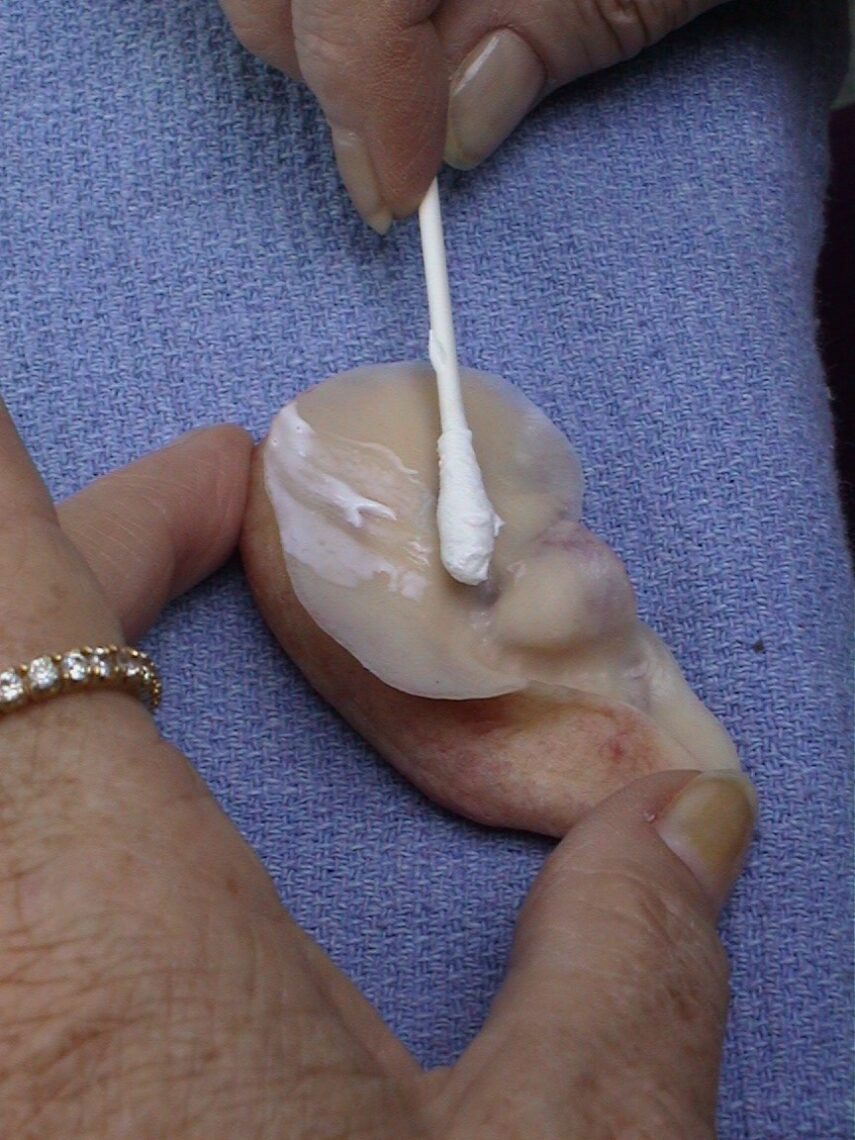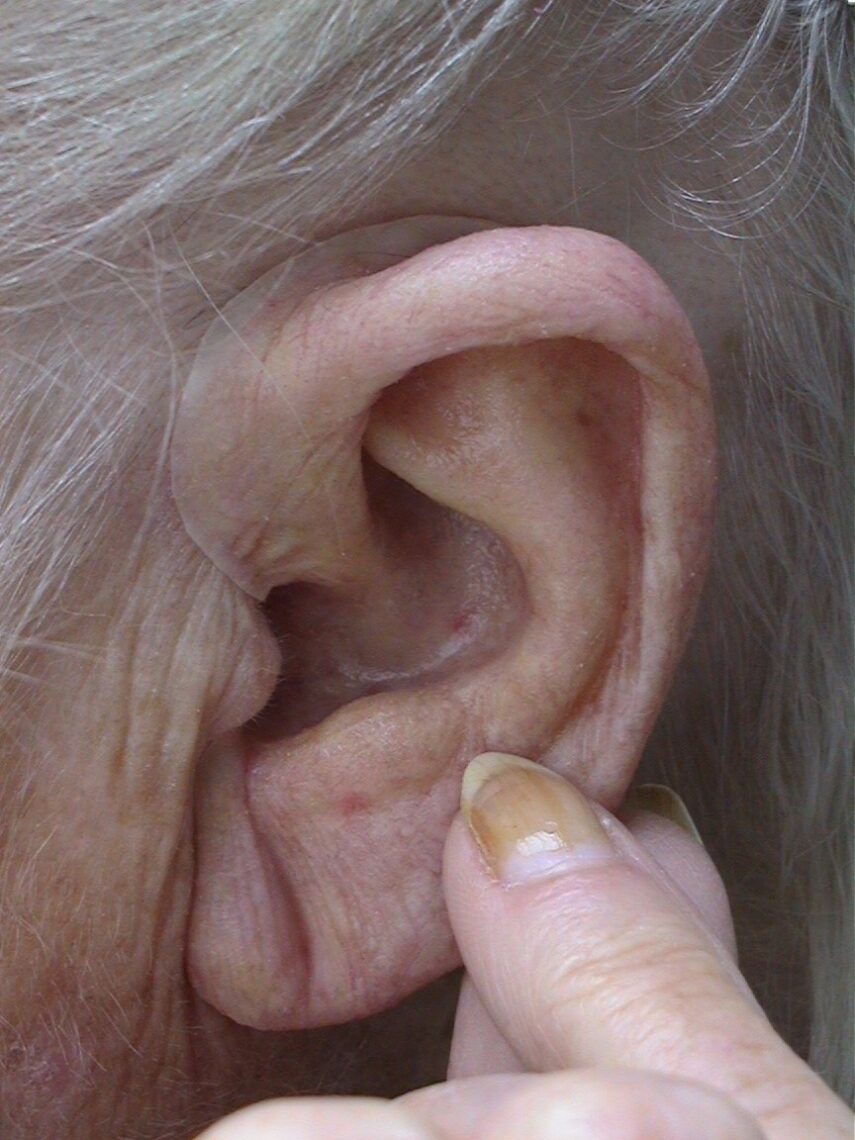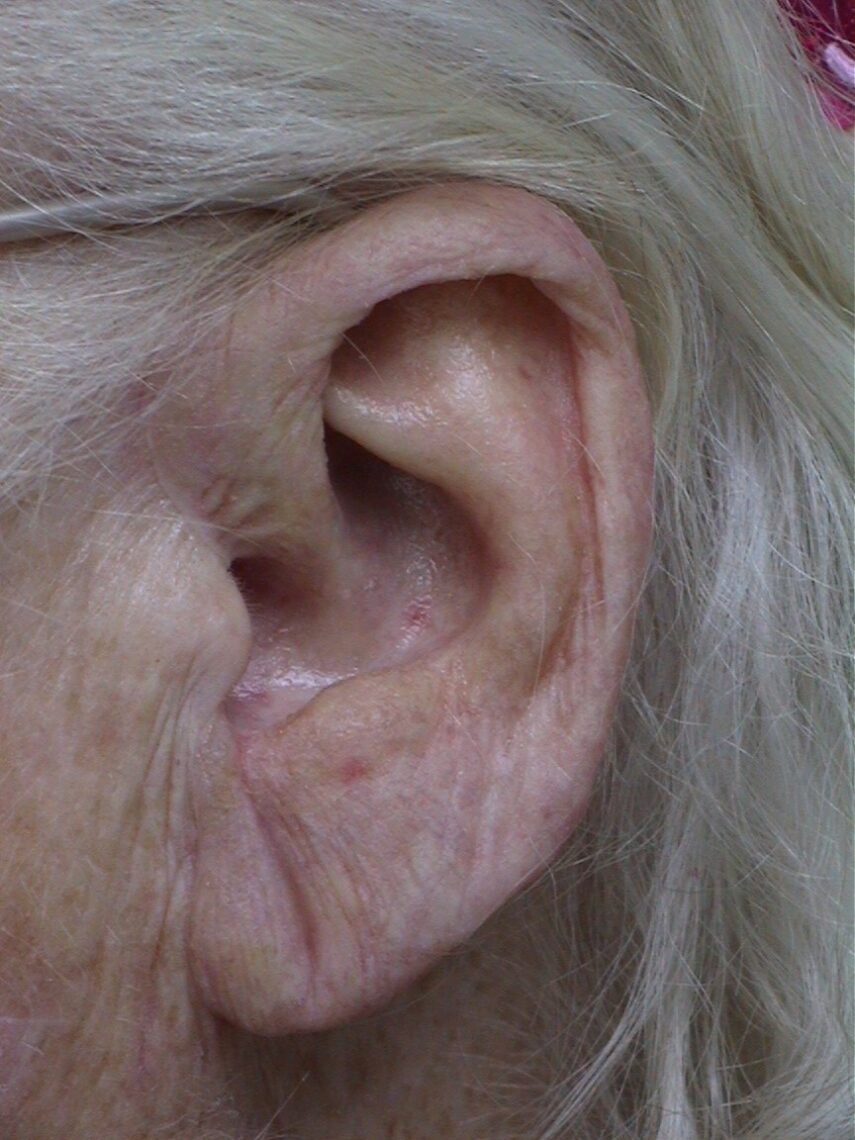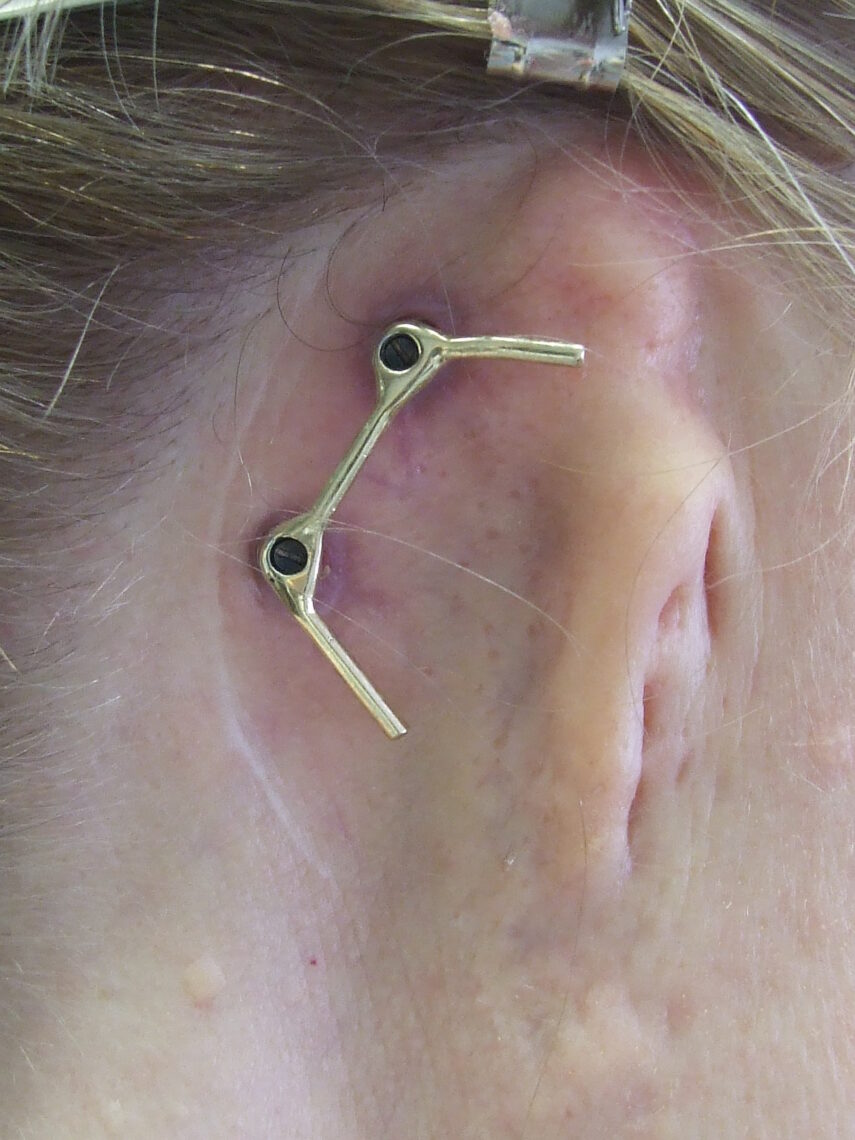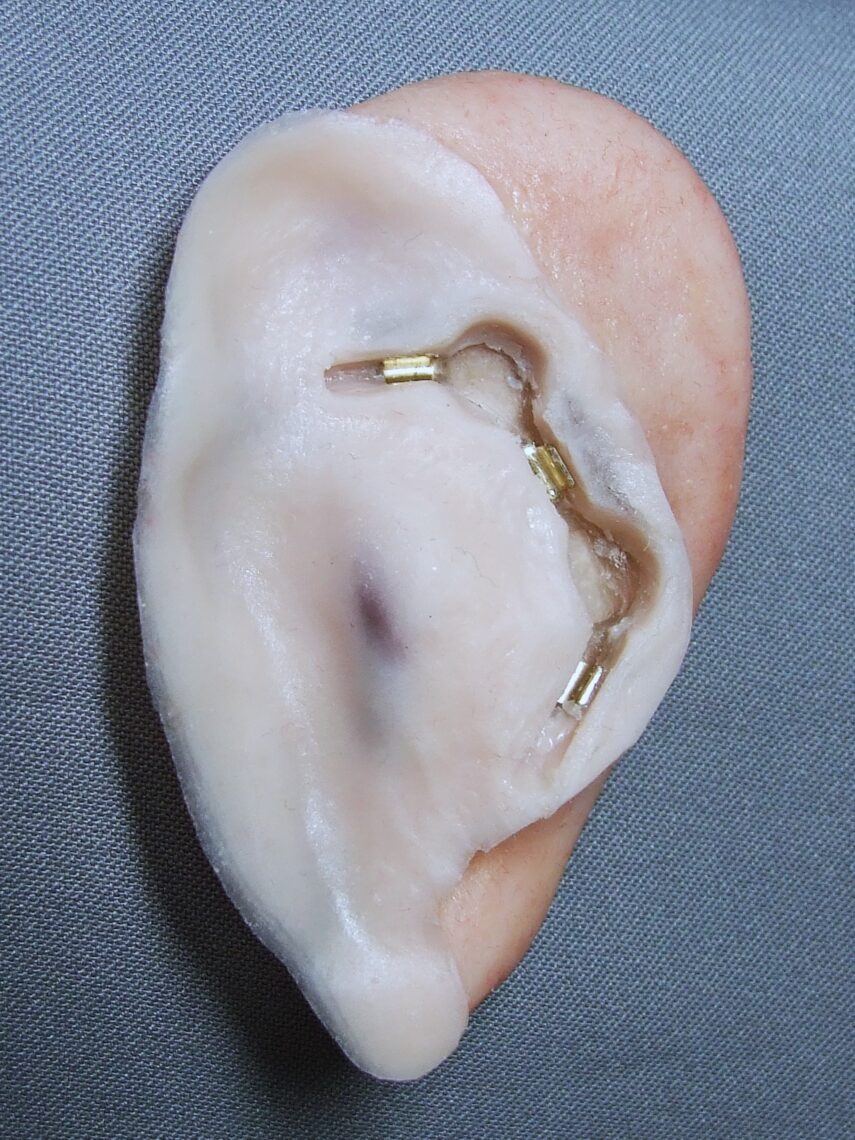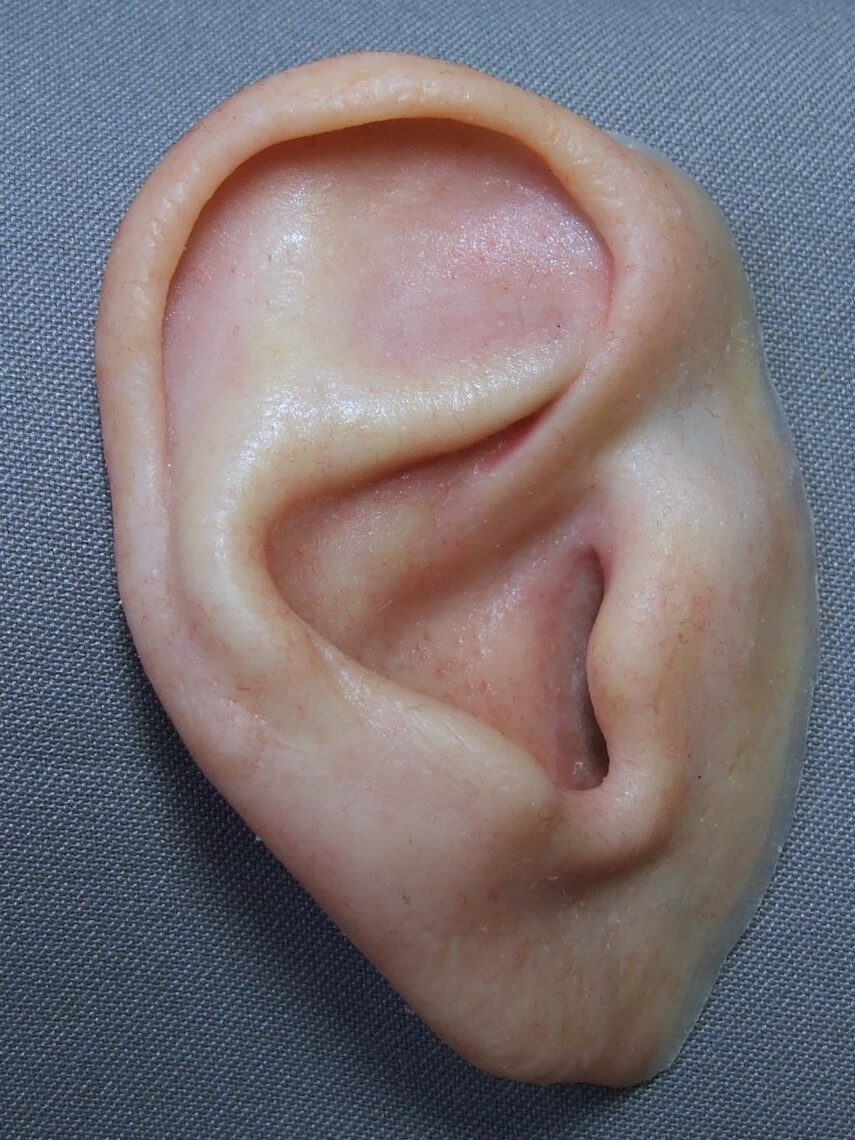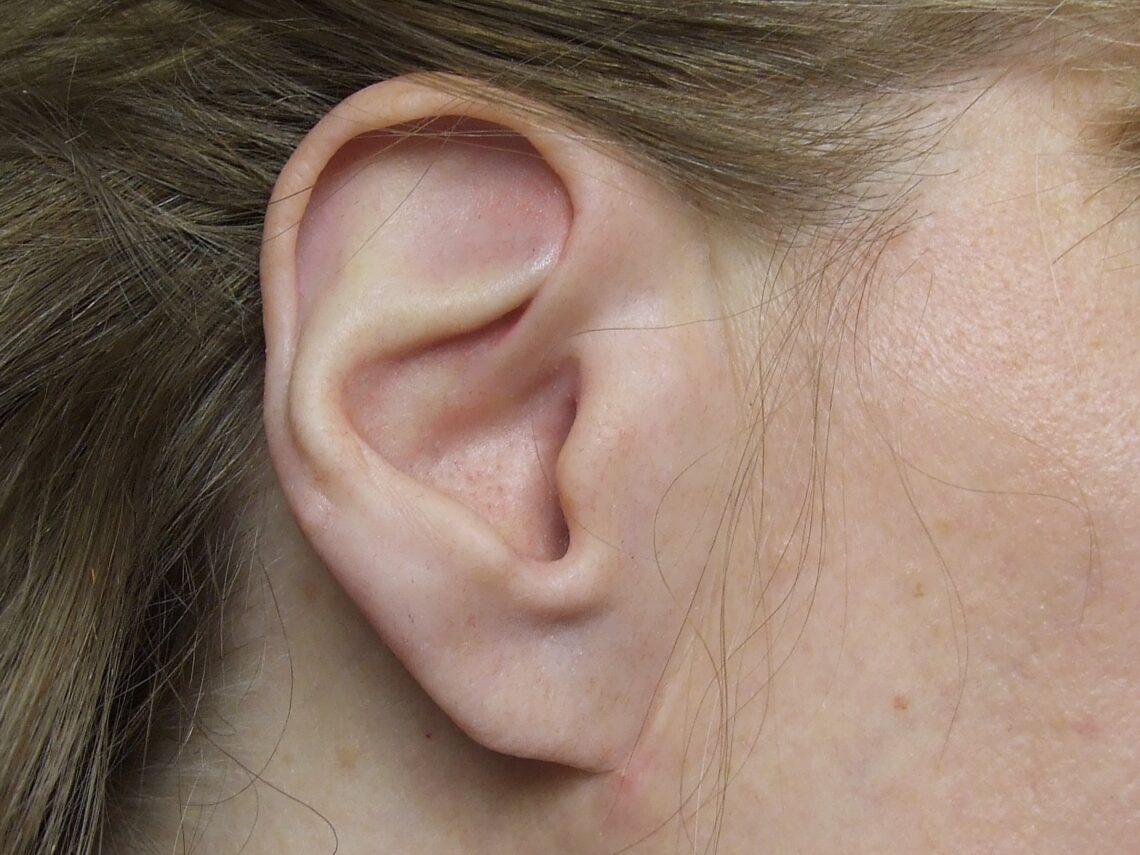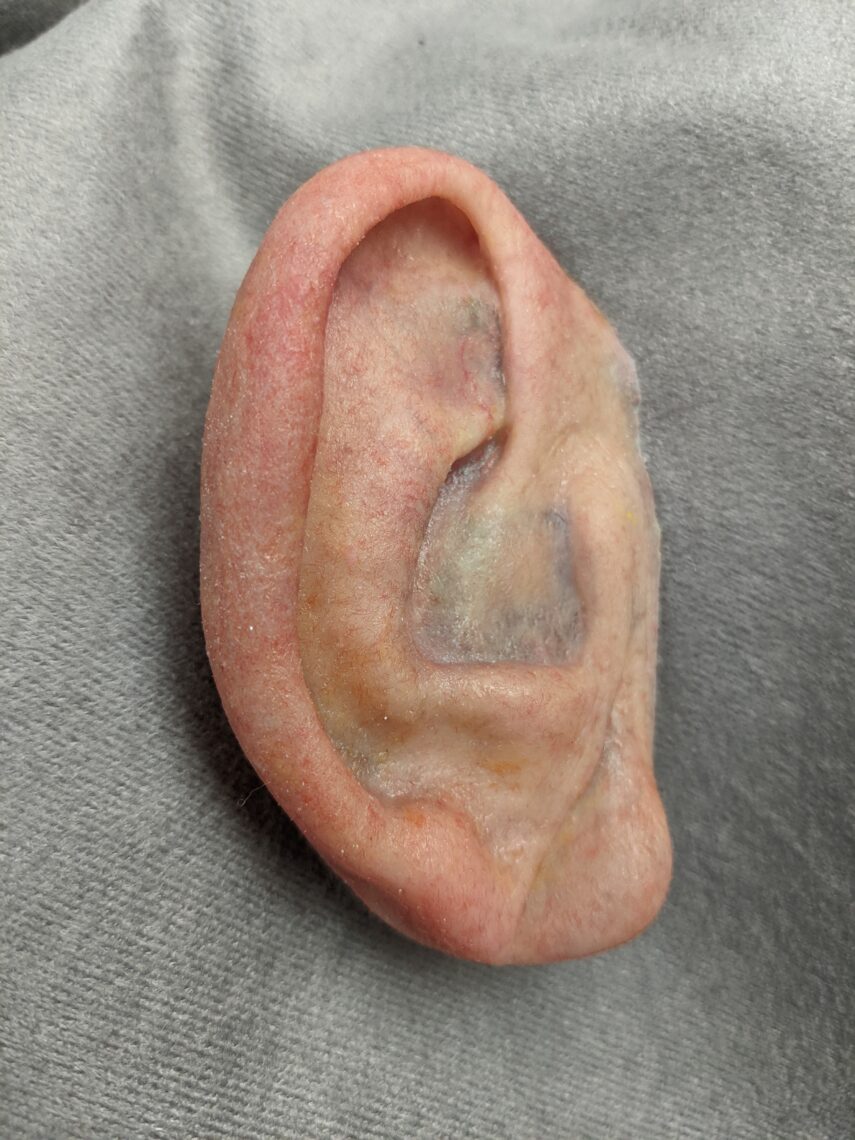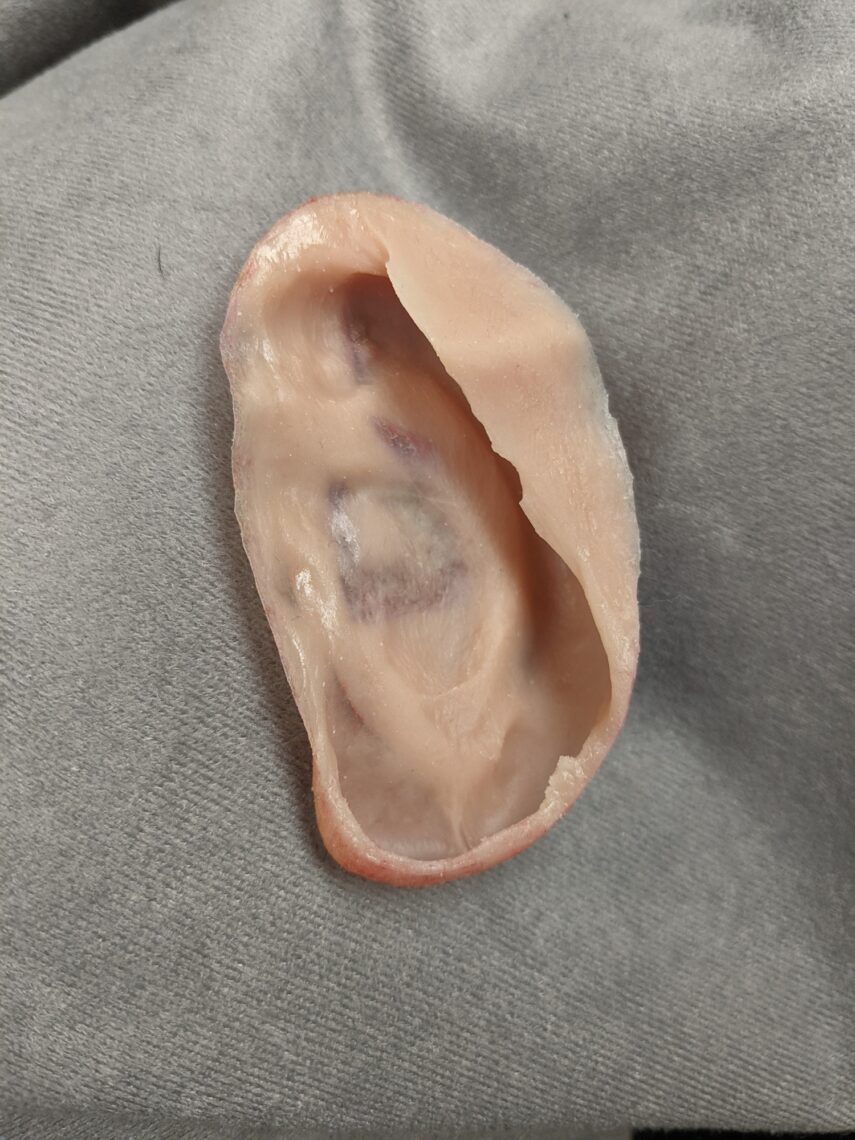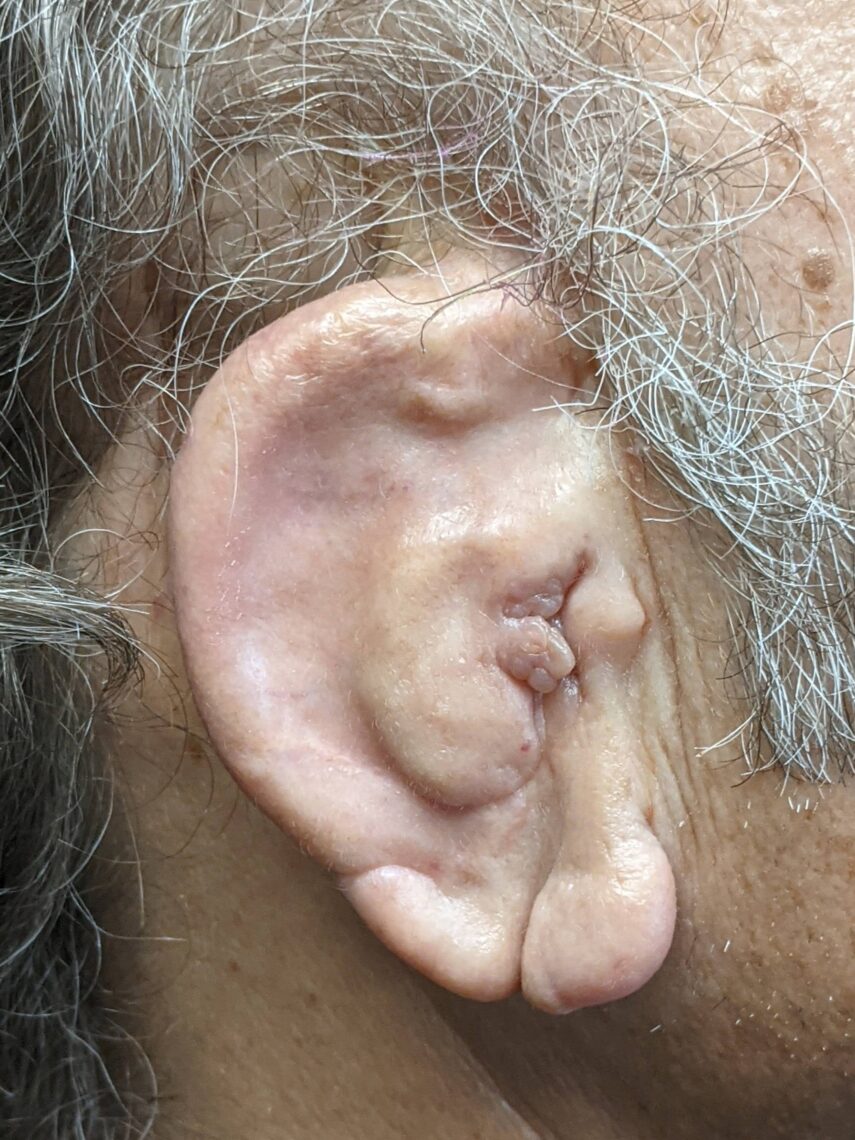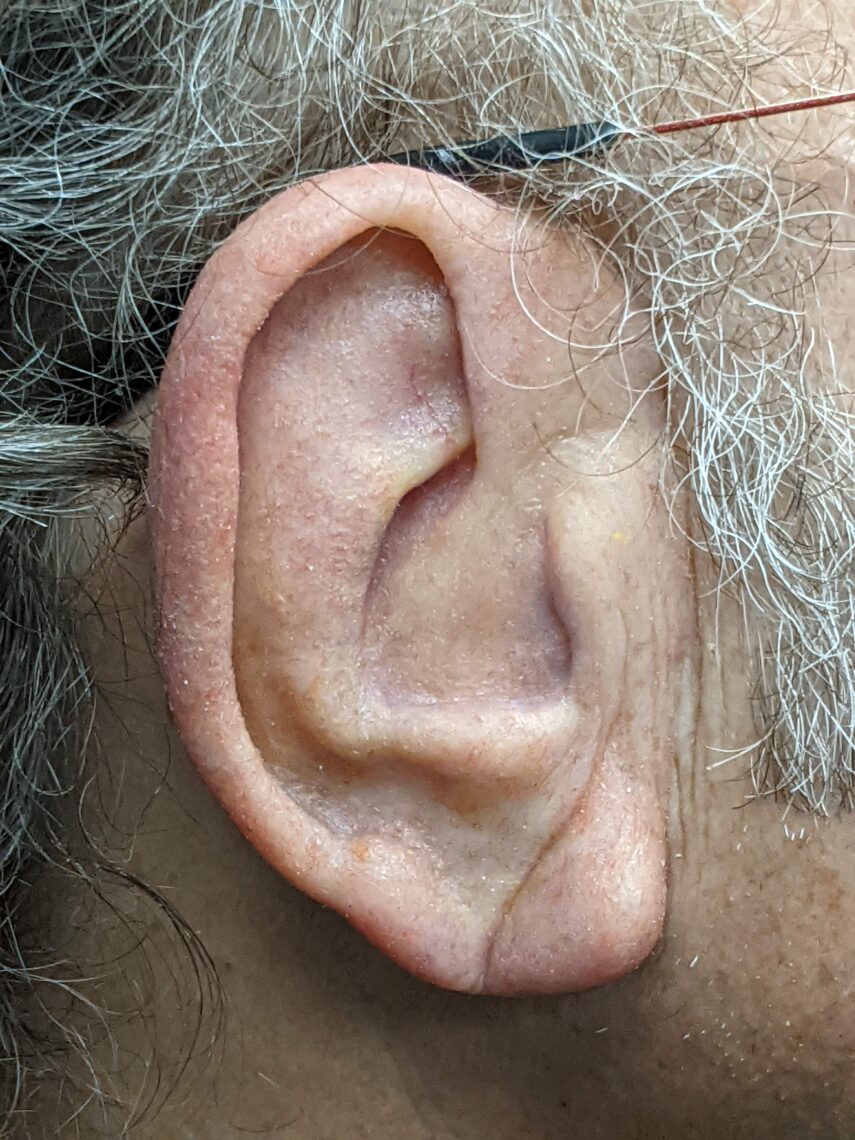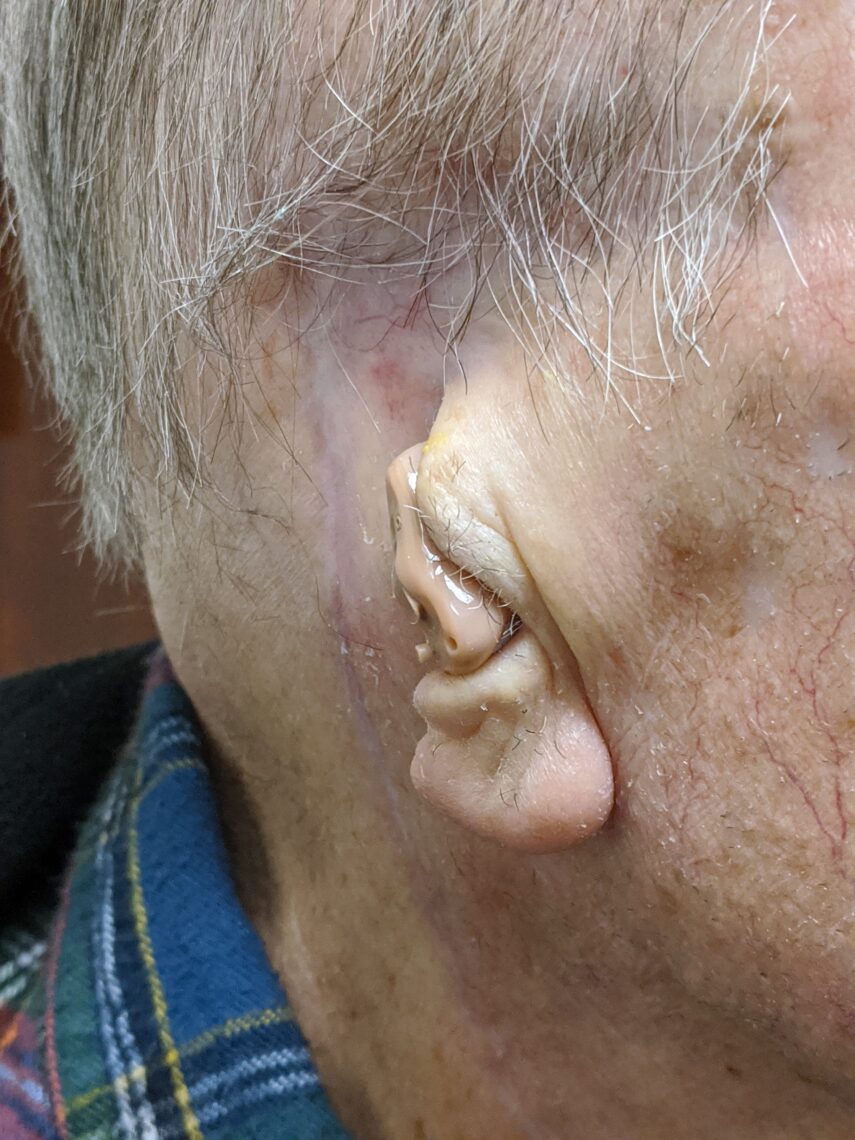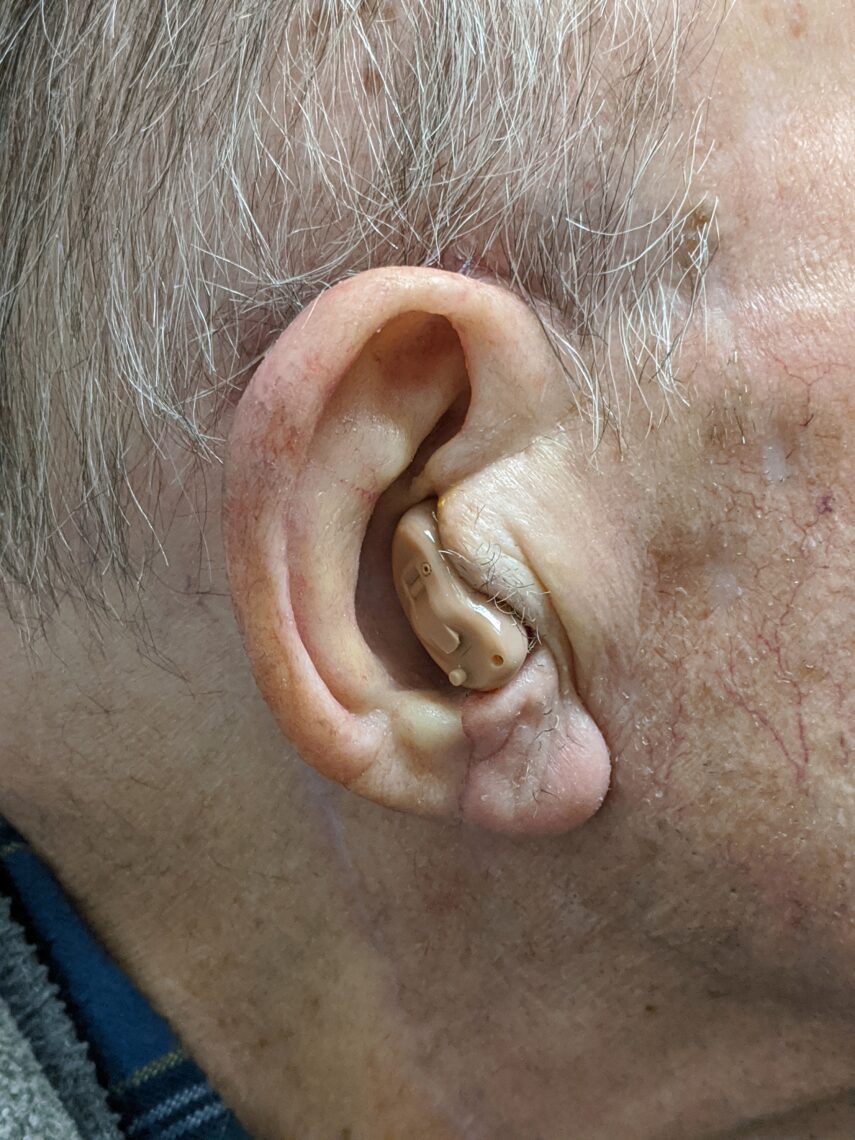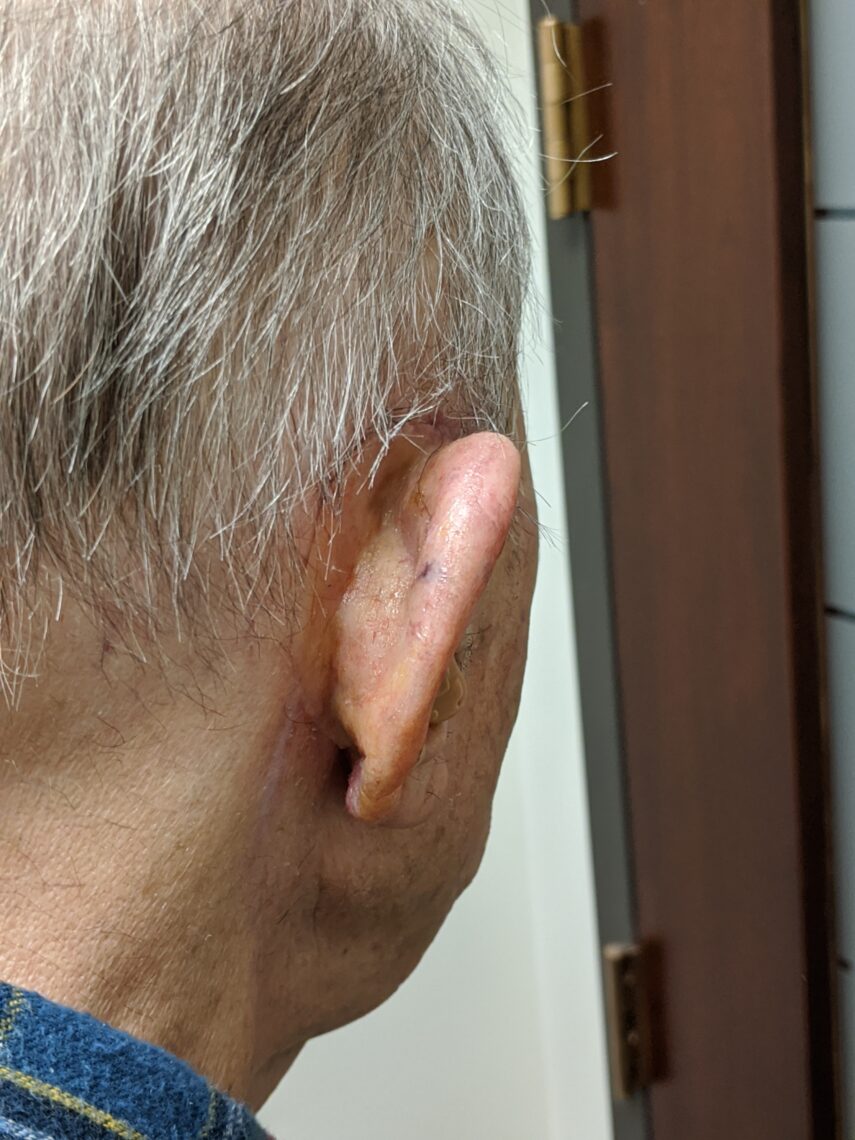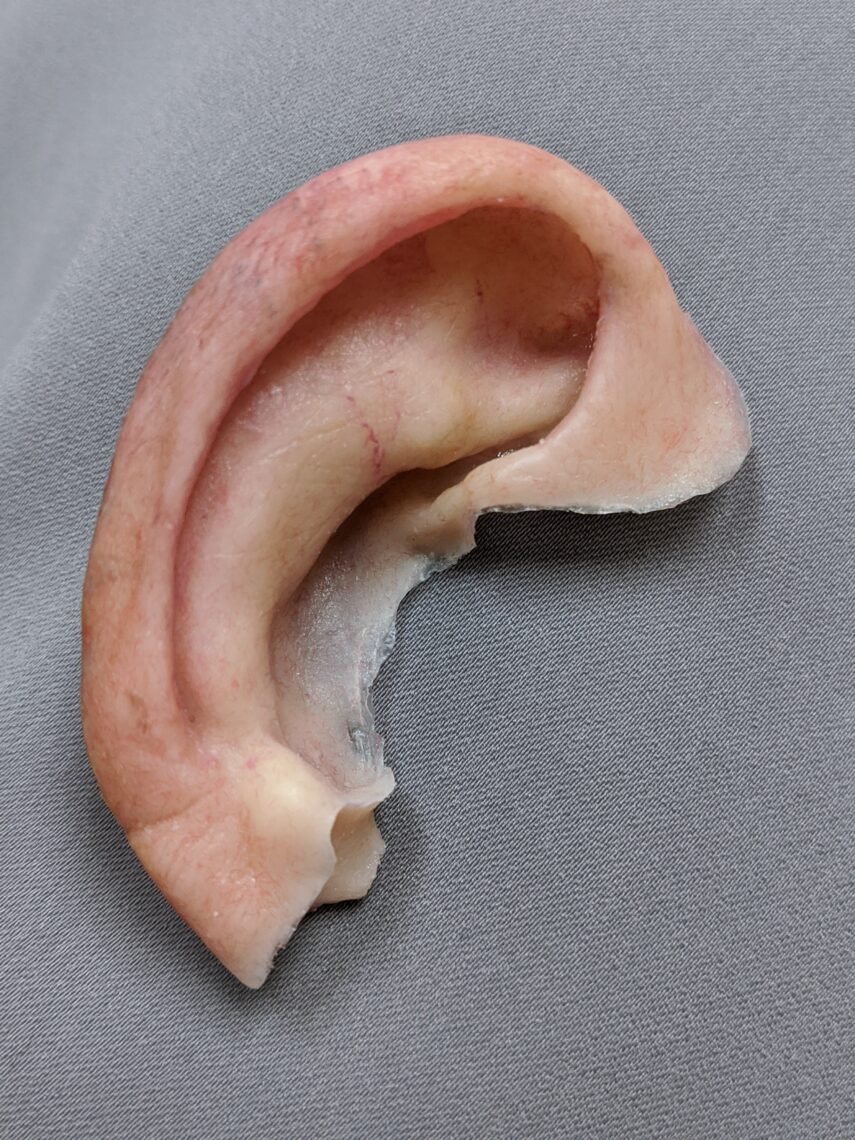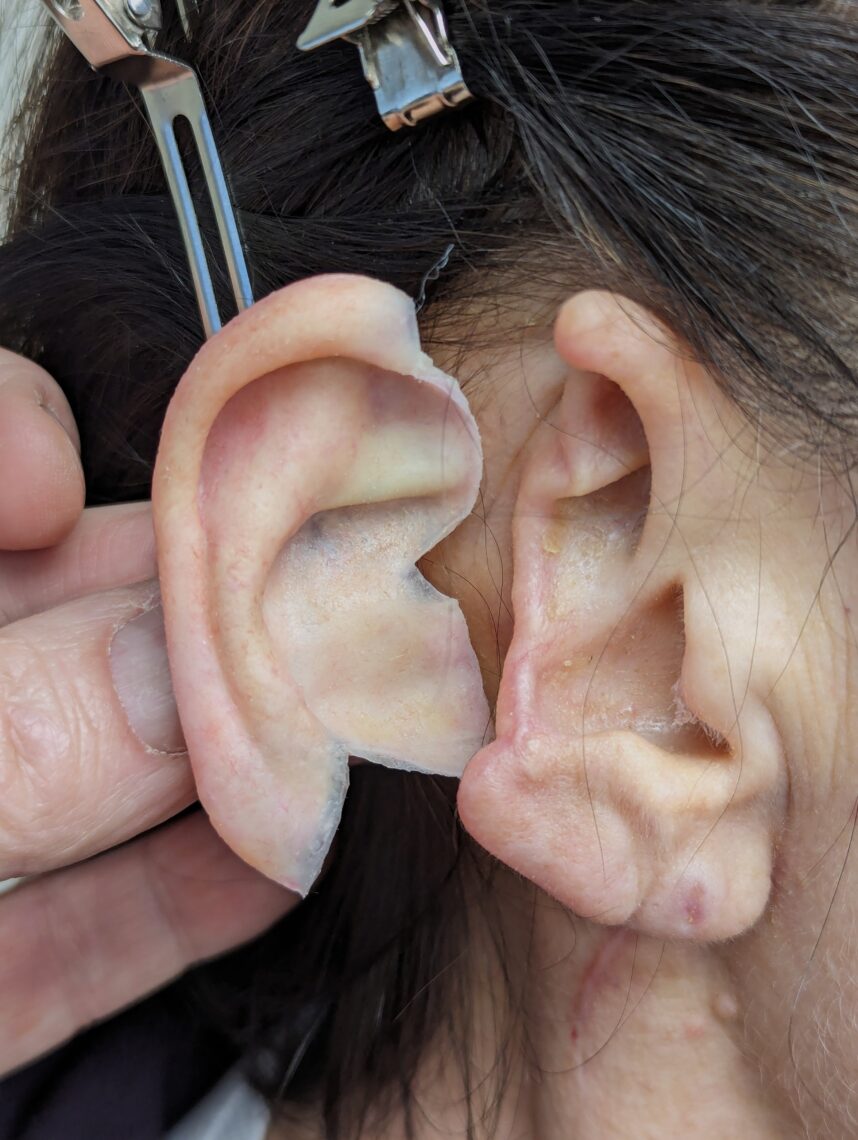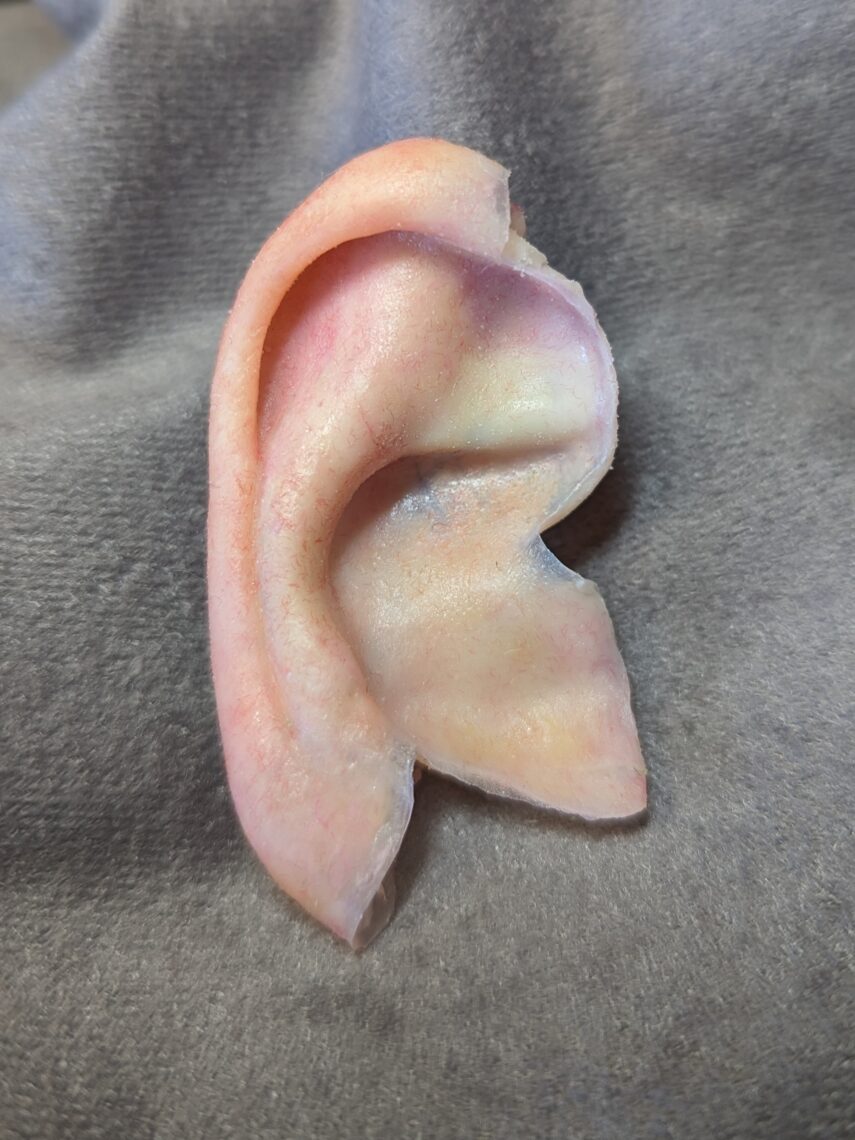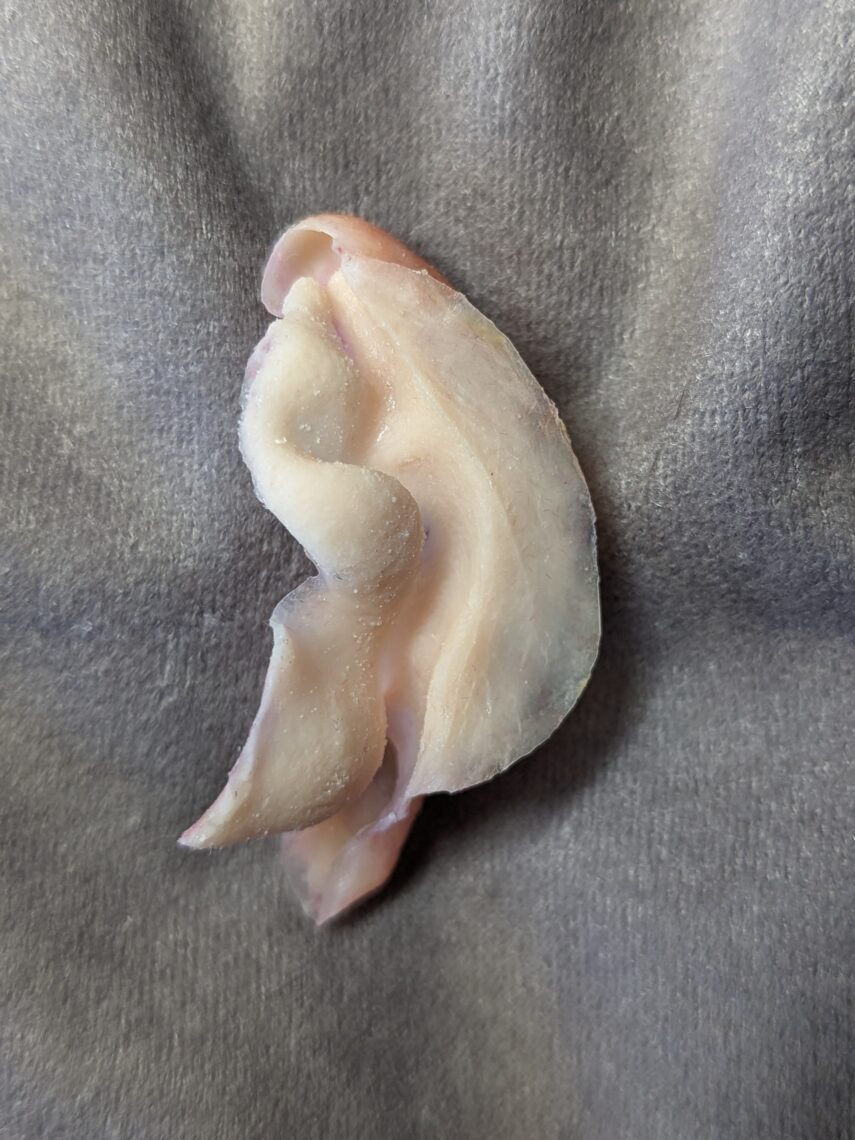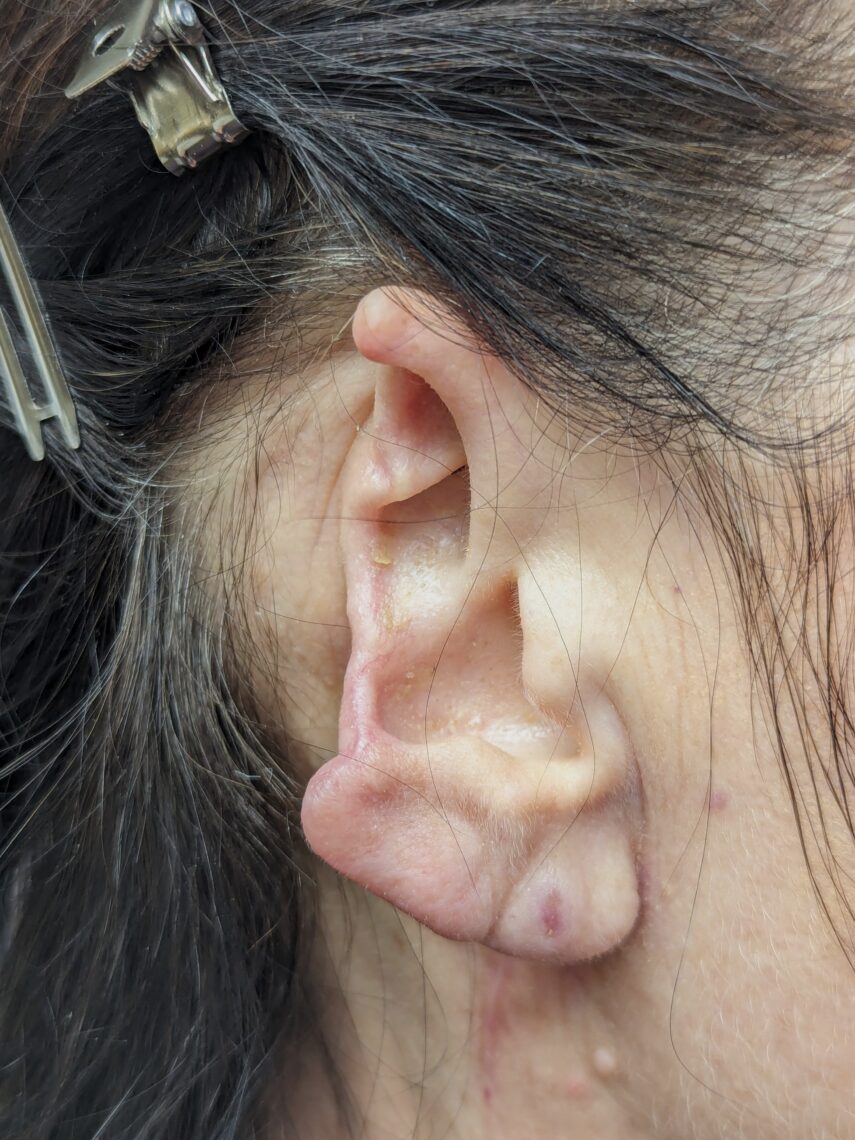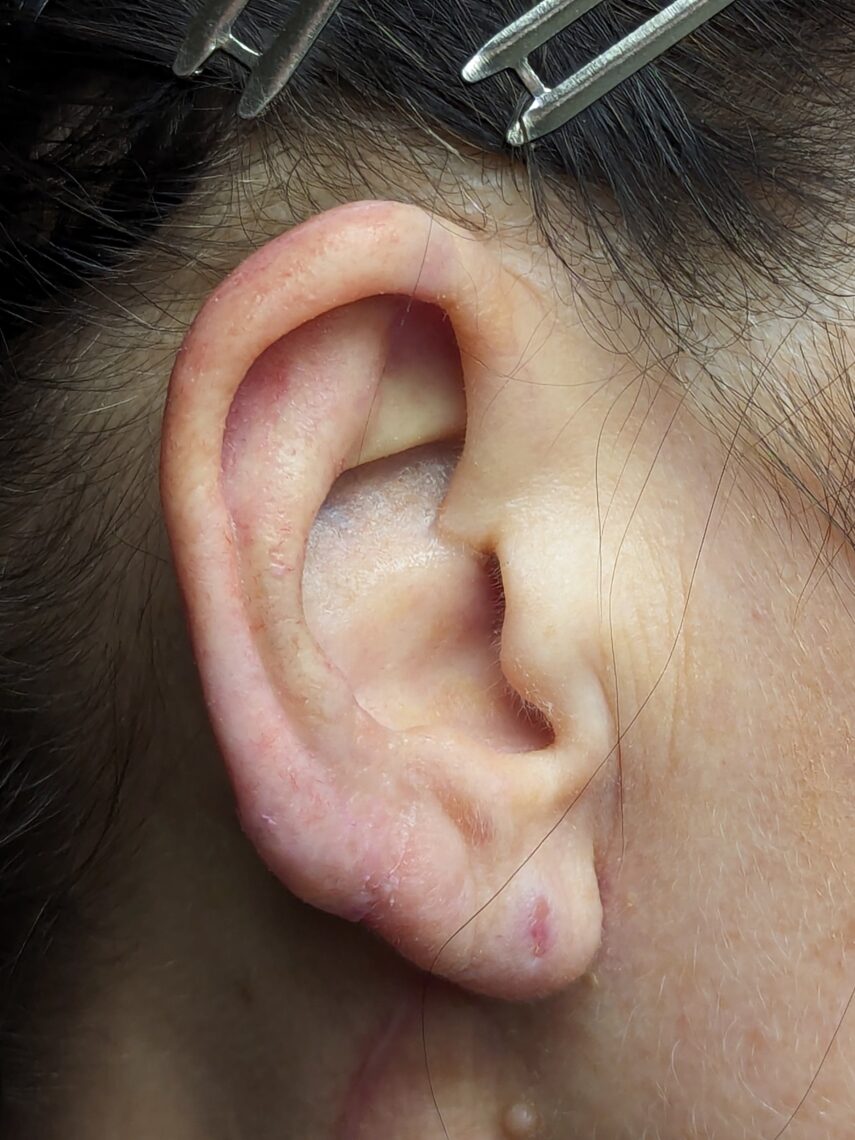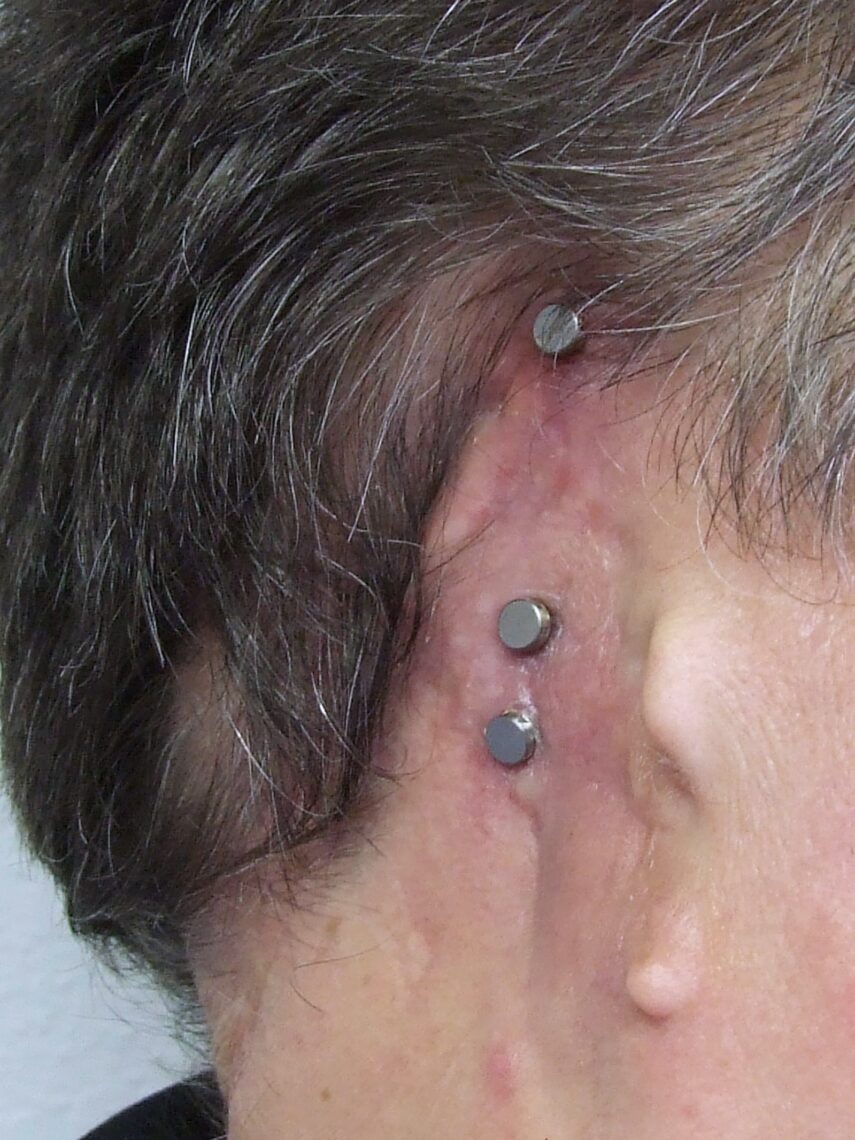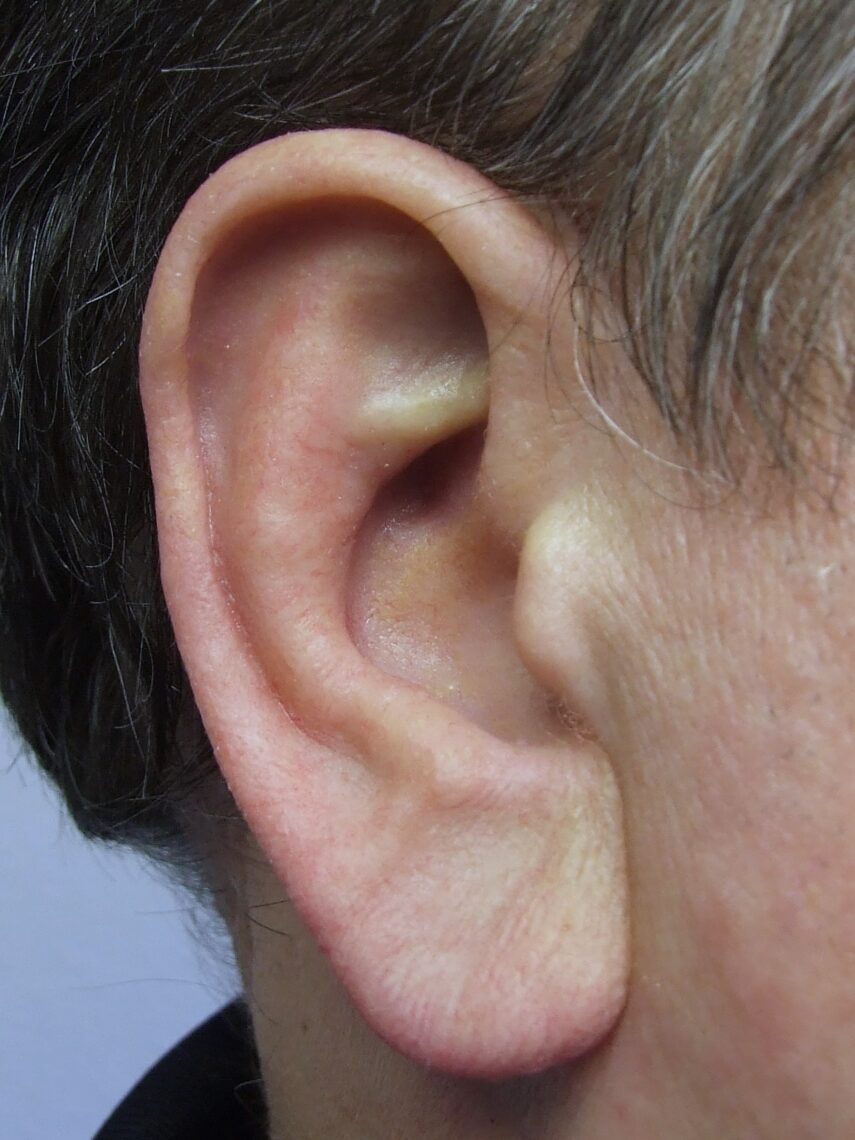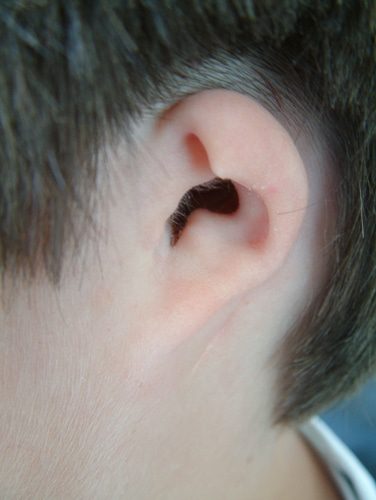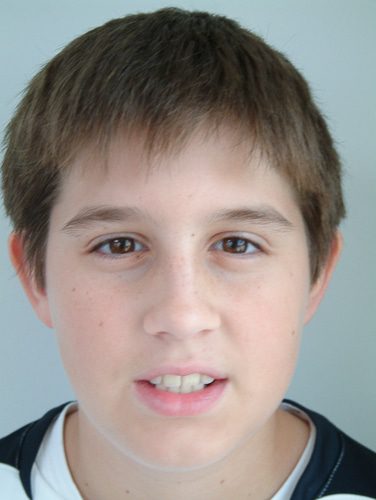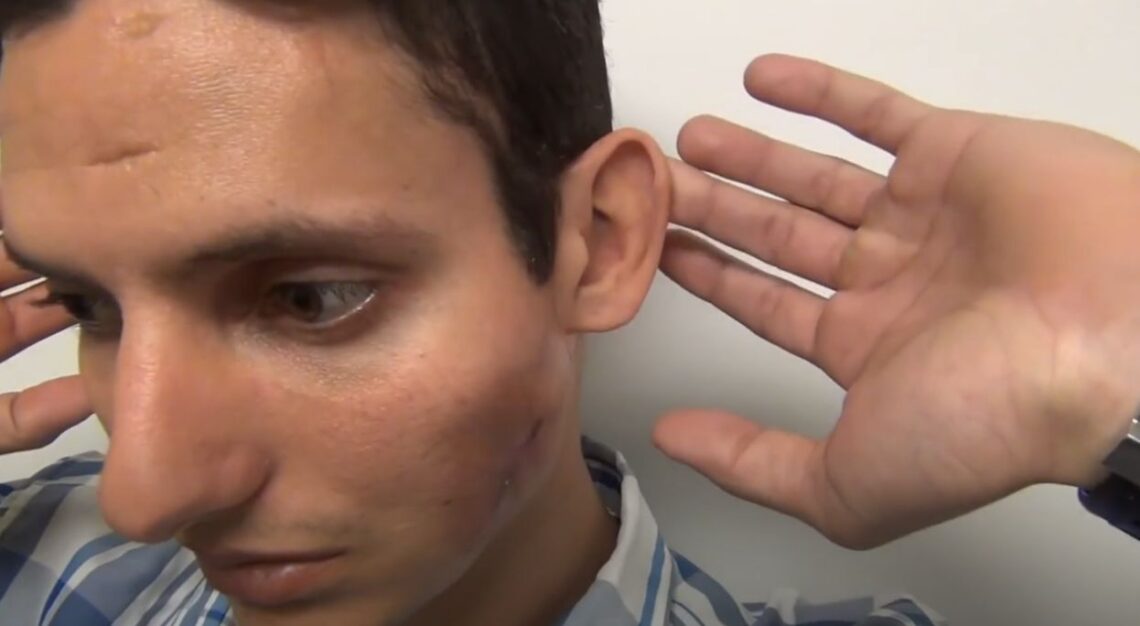Ear Prosthesis Retainment Options
We combine advanced 3-D technology with award-winning artistry. Customizing the ear prosthesis to meet and match an individual’s style can be achieved.
Creating a natural lifelike ear prosthesis appearance is accomplished by selective surface treatment: leaving sheen on select cartilaginous areas and a matte finish on adjacent helix and lobe to simulate much softer tissue covered by very fine vellus hair.

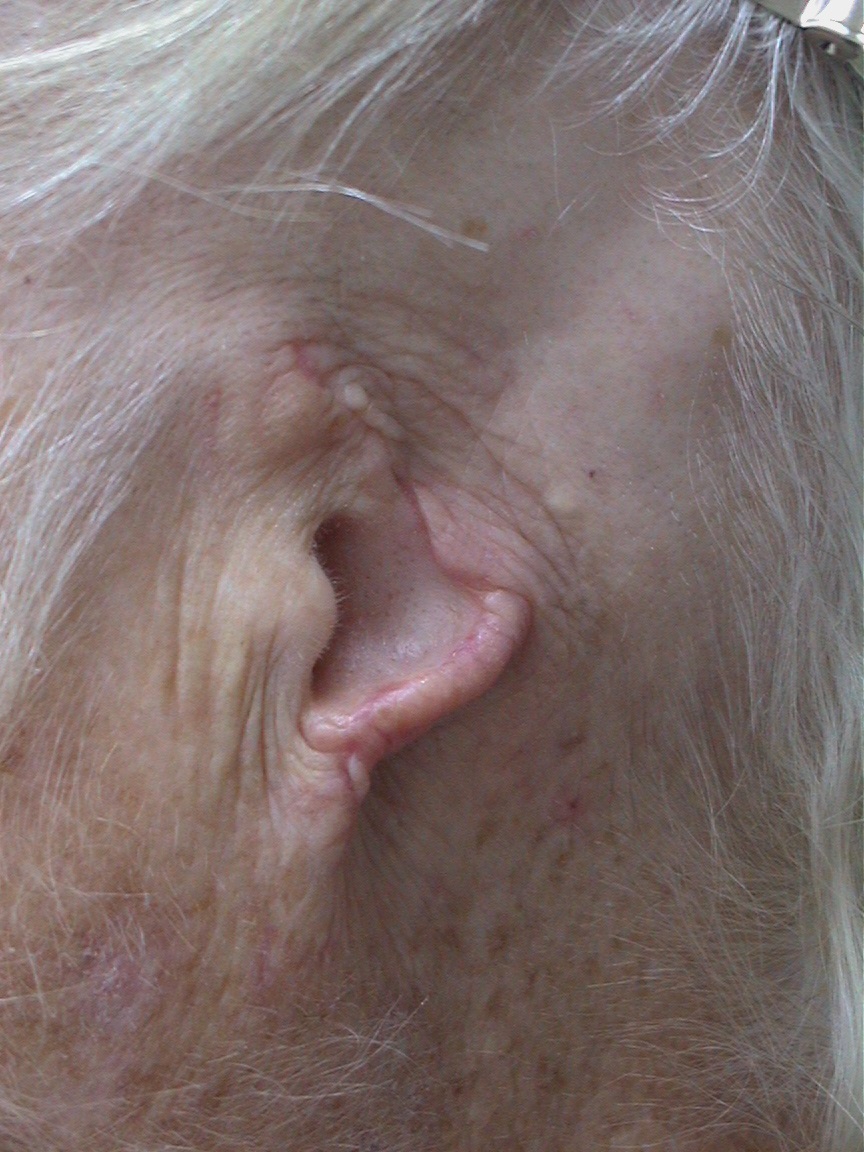
Adhesive-Retained Ear Prosthesis
Adhesive-Retained Ear Prosthesis
The conventional adhesive-retained ear prosthesis is the most immediate method of attachment. This is a non-surgical ear prosthesis. Adhesive is simply spread over the back surface and allowed to dry. Then the prosthesis is simply pressed into position for secure attachment. Medical Art Prosthetics has accumulated knowledge of adhesive chemistries spanning over 35 years. We often combine the best attributes of several adhesives. Our combination adhesive strategies result in an ear that is both very securely attached and also easier to clean. An easier to clean ear prosthesis means a longerlasting ear prosthesis.
Medical Art Prosthetics has developed completely unique attachment strategies to create virtually undetectable prosthetic ears and other facial prostheses.
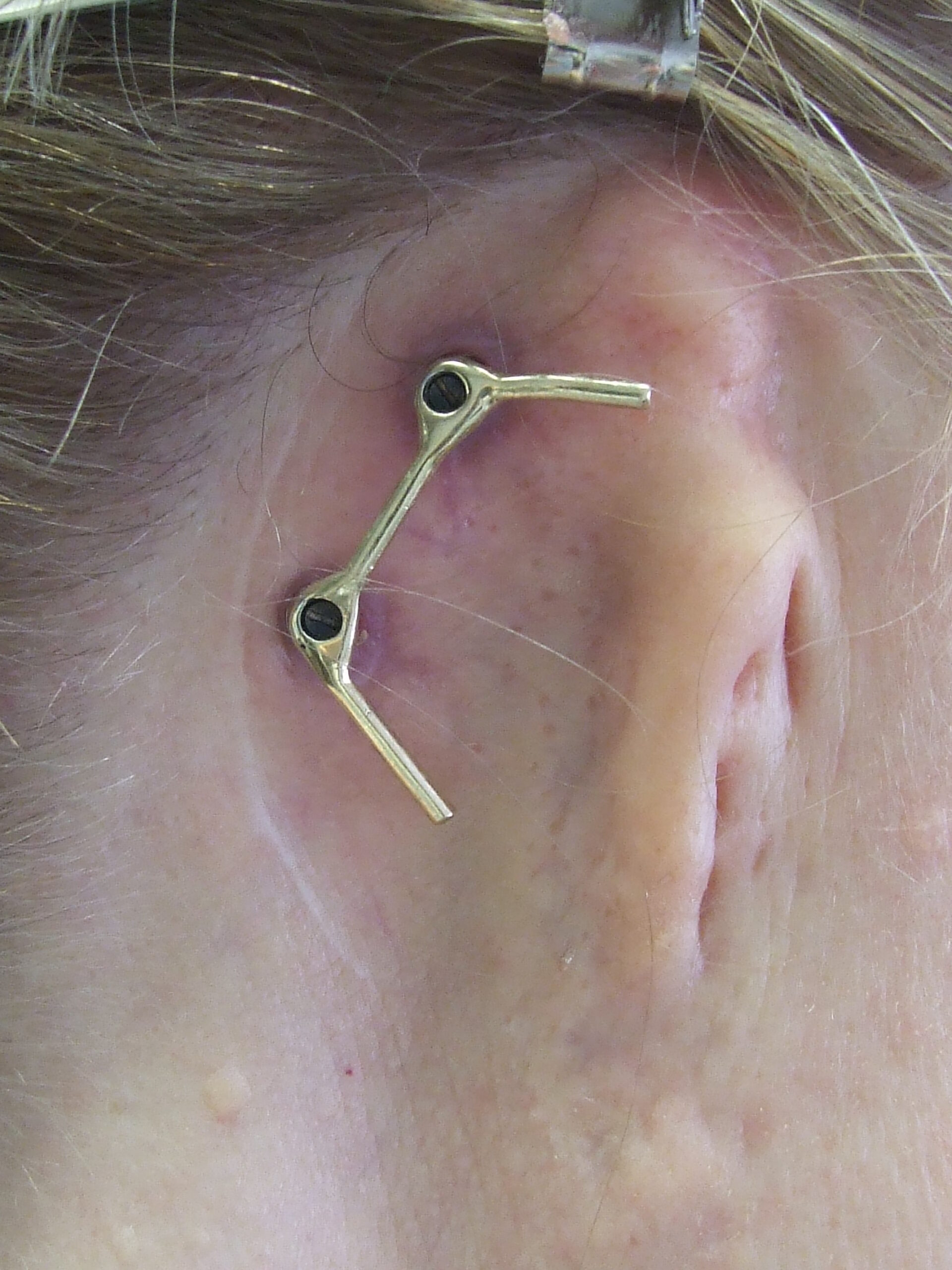
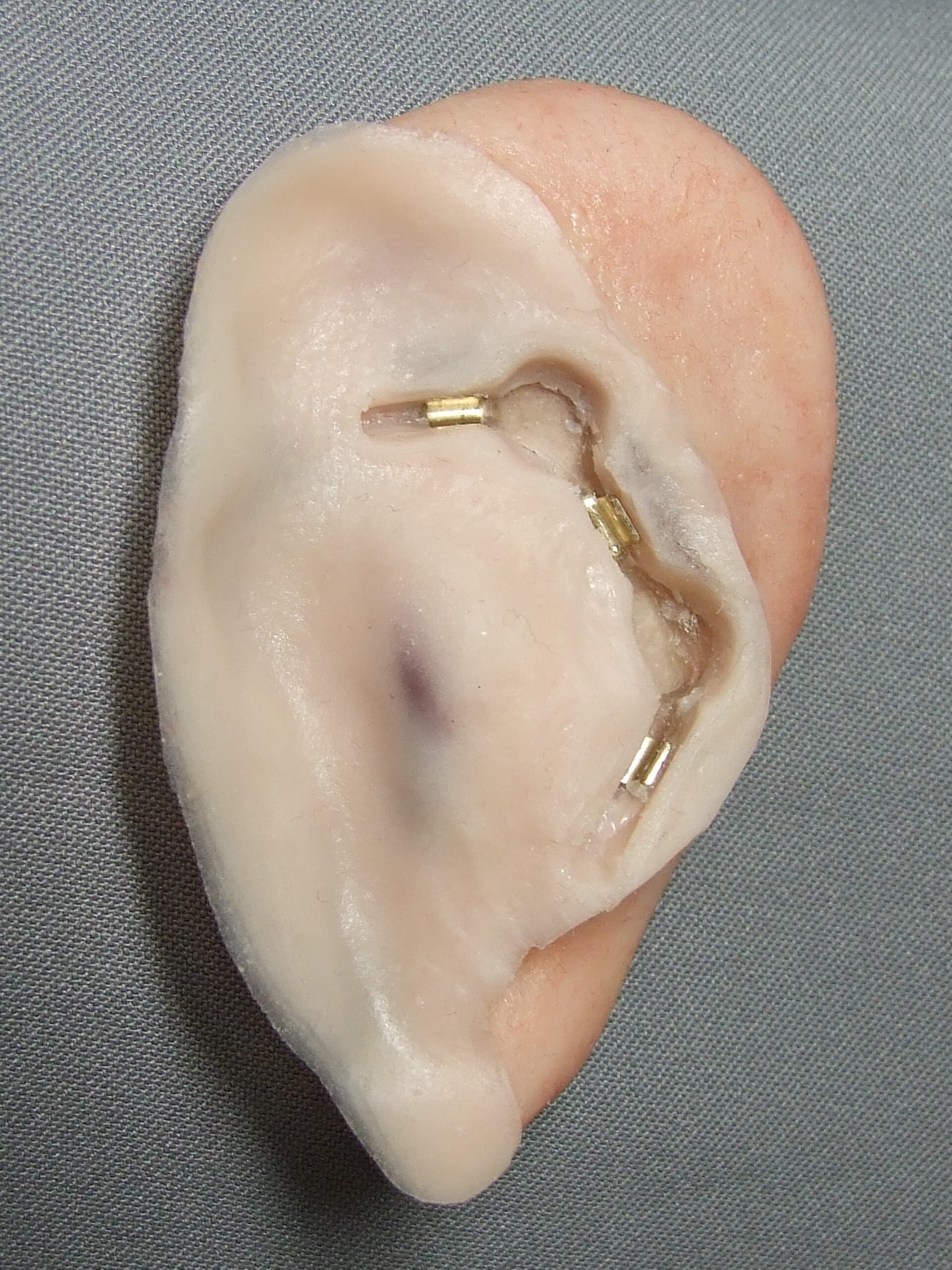
Implant-Retained Prostheses - Bar Clip Attachment
Implant-Retained Prostheses - Bar Clip Attachment
The bar-clip attachment has been the conventional method of attachment when designing osseointegration implant-retained auricular prostheses. These patients received their osseointegration surgeries and the fabrication of the bar and their initial silicone prosthesis at other facilities. They then visited Medical Art Prosthetics for a new ear prosthesis with improved design and aesthetics which were created and delivered in 3 or 4 days.
Medical Art Prosthetics regularly receives referrals from out of state clients who have a stable bone-anchored bar-splint. But they come to us for a short stay to have a new clip-attached ear prosthesis improved with higher levels of detail, lifelike realism, and durability.
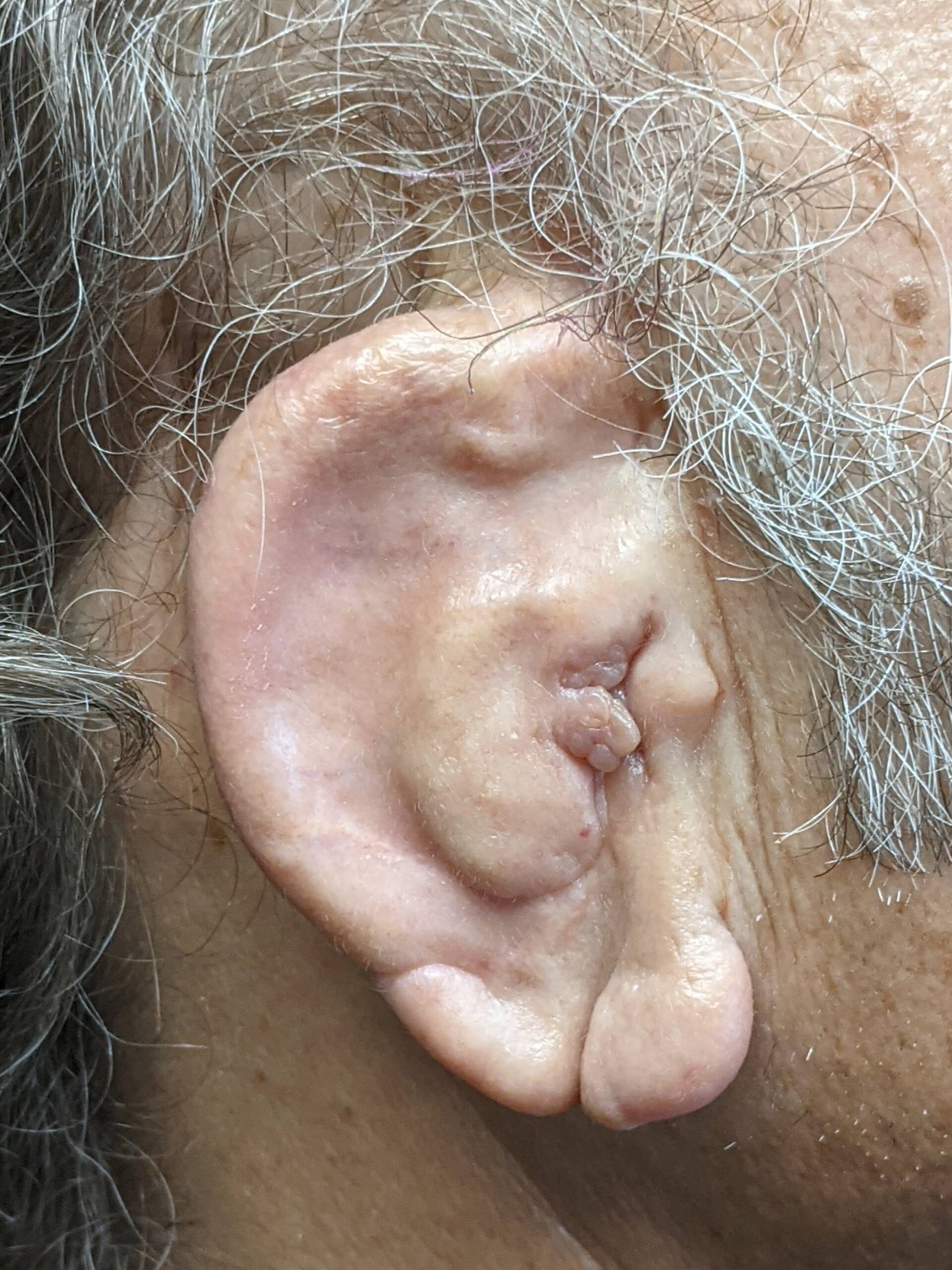
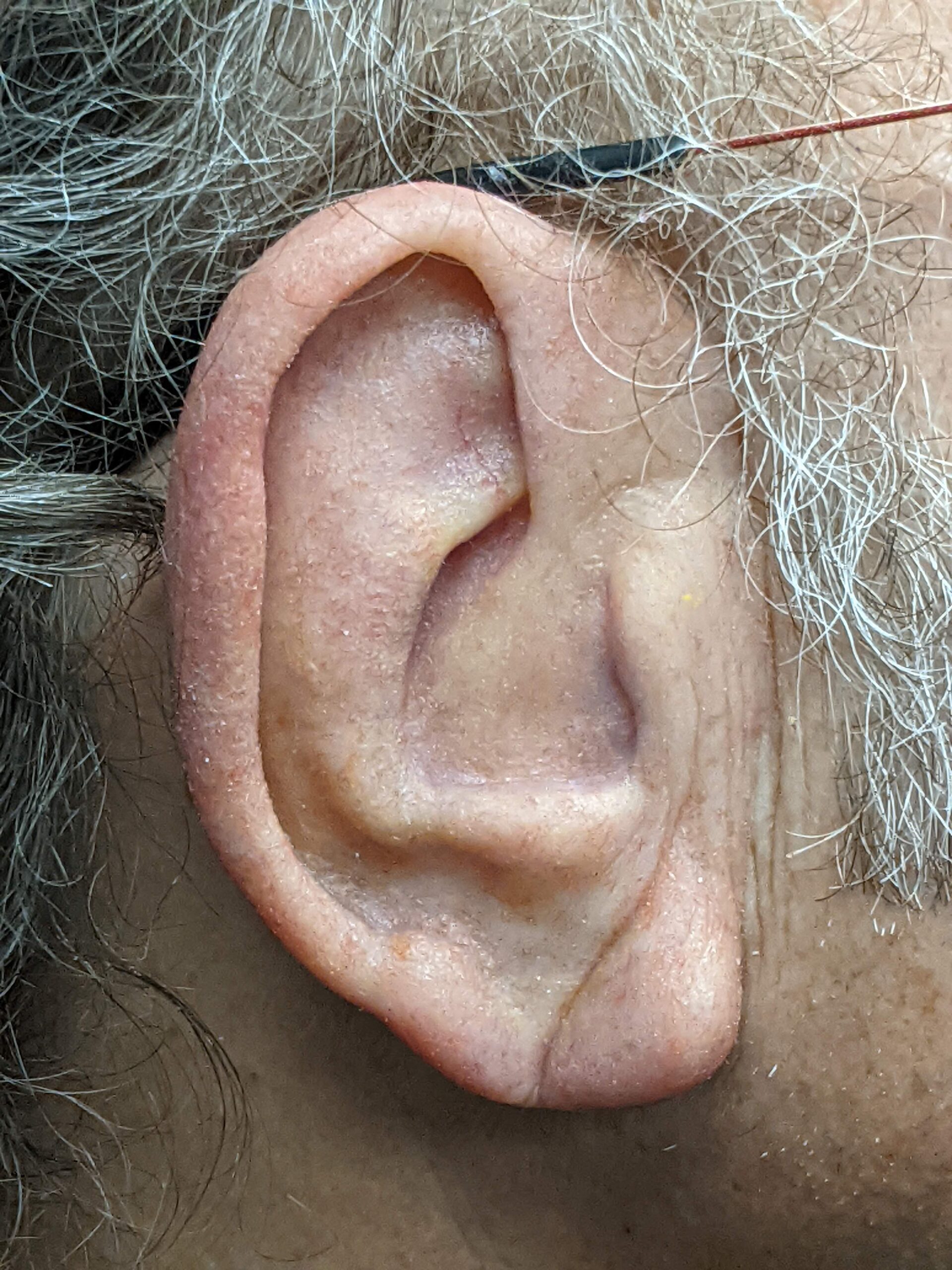
The Slip-Over Ear Prosthesis- Keep Your Surgical Ear Reconstruction
The Slip-Over Ear Prosthesis- Keep Your Surgical Ear Reconstruction
Adults having lived with suboptimal autologous ear reconstruction are understandably conflicted in deciding whether to seriously consider purchasing a lifelike prosthetic ear. This is because they are told or they assume that their ear cartilage constructs must be completely surgically removed for the installation of osseointegrated implants. It is generally true that the implant-retained type prosthesis would require complete sacrifice of the ear construct. The surgical removal of the ear would be followed by further thinning of soft tissue in the area and attachment of that skin to the bone periosteum for the installation of osseointegration fixtures and abutments. Although this might ultimately be the best long term prosthetic attachment method for many of our patients, there is the option to keep their ear reconstructions by creating a slip-over type prosthesis that greatly improves the anatomical aesthetics of the ear.
Slip-over silicone ear prostheses in many cases attain excellent aesthetics and stay in place nicely by engaging the underlying ear cartilage undercuts. In ideal cases like this the prosthesis can be slipped on and off in seconds using a small amount of water soluble lubricant, and requires only simple soaping and rinsing for daily care. Creating the delicate shapes of the helix, antihelix, tragus, etc. over the underlying ear shape is extremely painstaking, but if done with care and precision the improved anatomical ear shape can be liberating. New hairstyles can be worn to show off the new ear with confidence.
This approach gives the patient a chance to see what it is like to have and wear prostheses each day. It allows them time to know the nature of prosthesis wear and decide if the slip-over version is perhaps suitable for their own lifestyle. This is a helpful option before taking the irreversible step of having rib cartilage reconstructions surgically removed for osseointegrated implants.
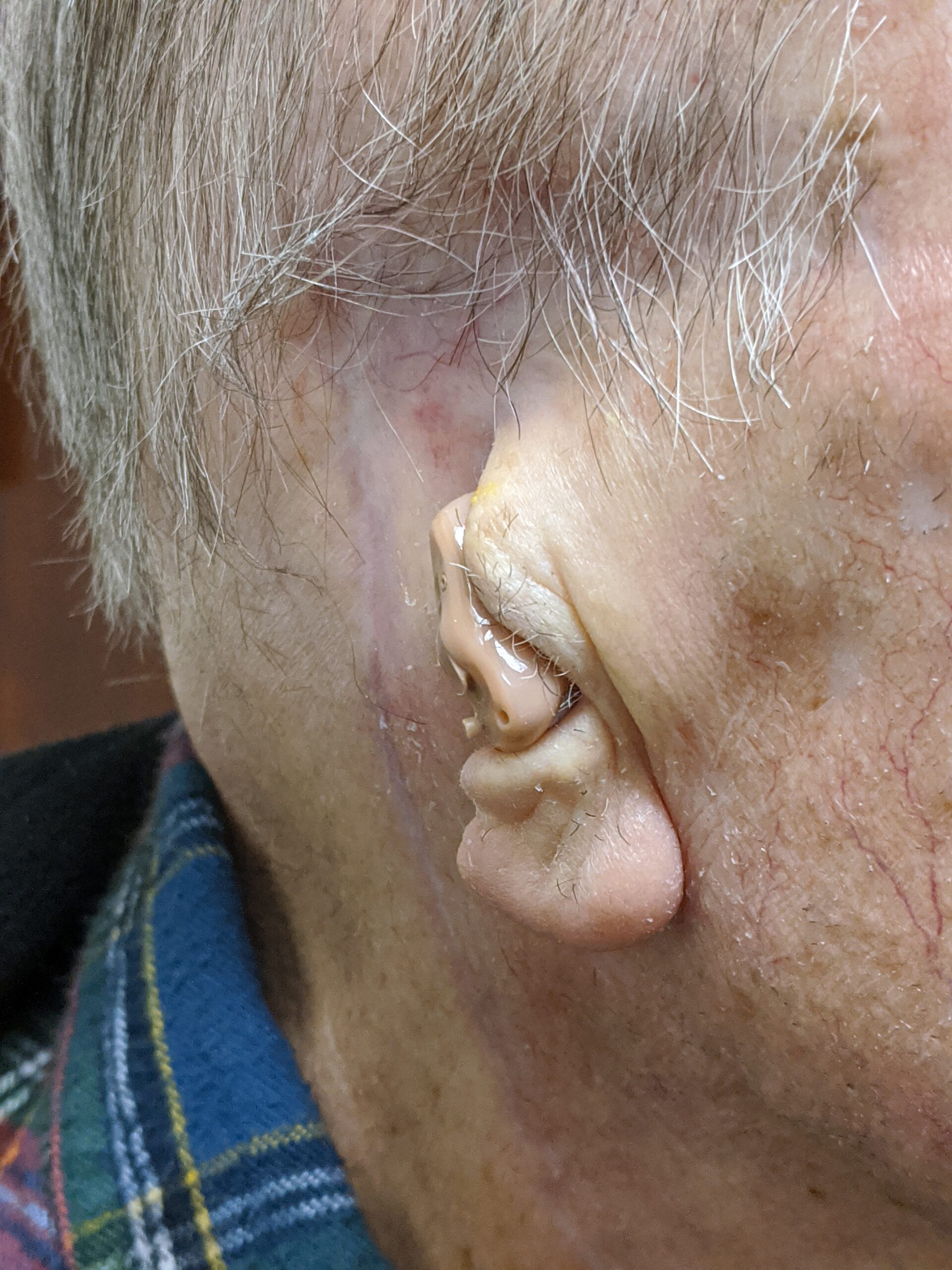
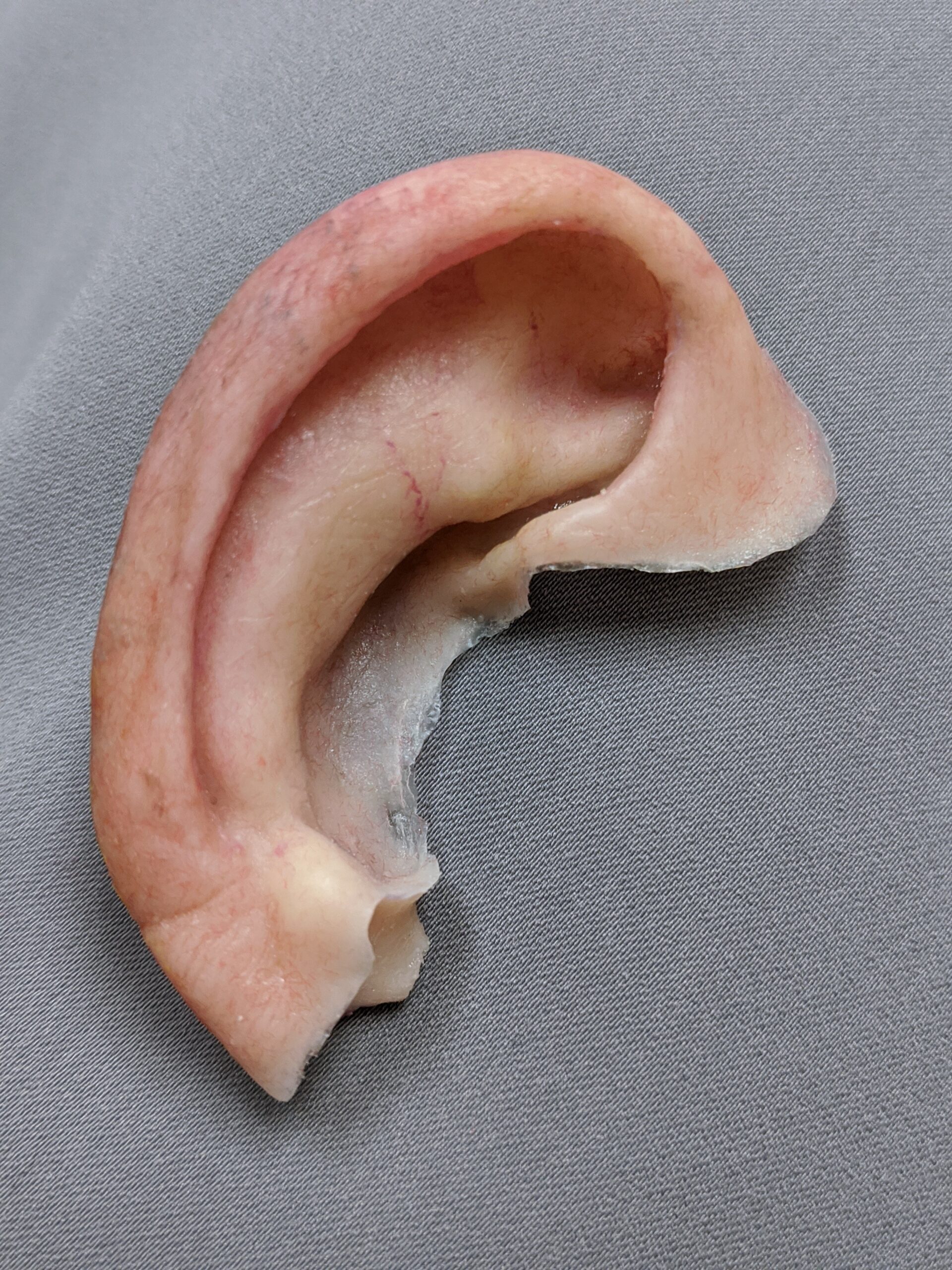
Mechanically-Retained Ear Prostheses
Mechanically-Retained Ear Prostheses
Subtotal auriculectomy of the upper half of the pinna leaves the cartilaginous structure of the ear remnant intact. This helps to support the partial ear prosthesis. The silicone prosthesis in this case rests on the lower half of the remnant ear. Adhesive may be applied under the margins for a secure seal. In this case the patient will feel secure just by placing his hearing aid and his glasses to hold his prosthesis in place. In some cases we create a groove into the top of the ear prosthesis if the patient wants the extra security of attaching the ear prosthesis to his eyeglasses. Adhesive may then be applied as an option.
Ear restoration and anaplastology is our specialty and we know how much easier it will be for our patient to manage his ear prosthesis each day without reliance on adhesives.

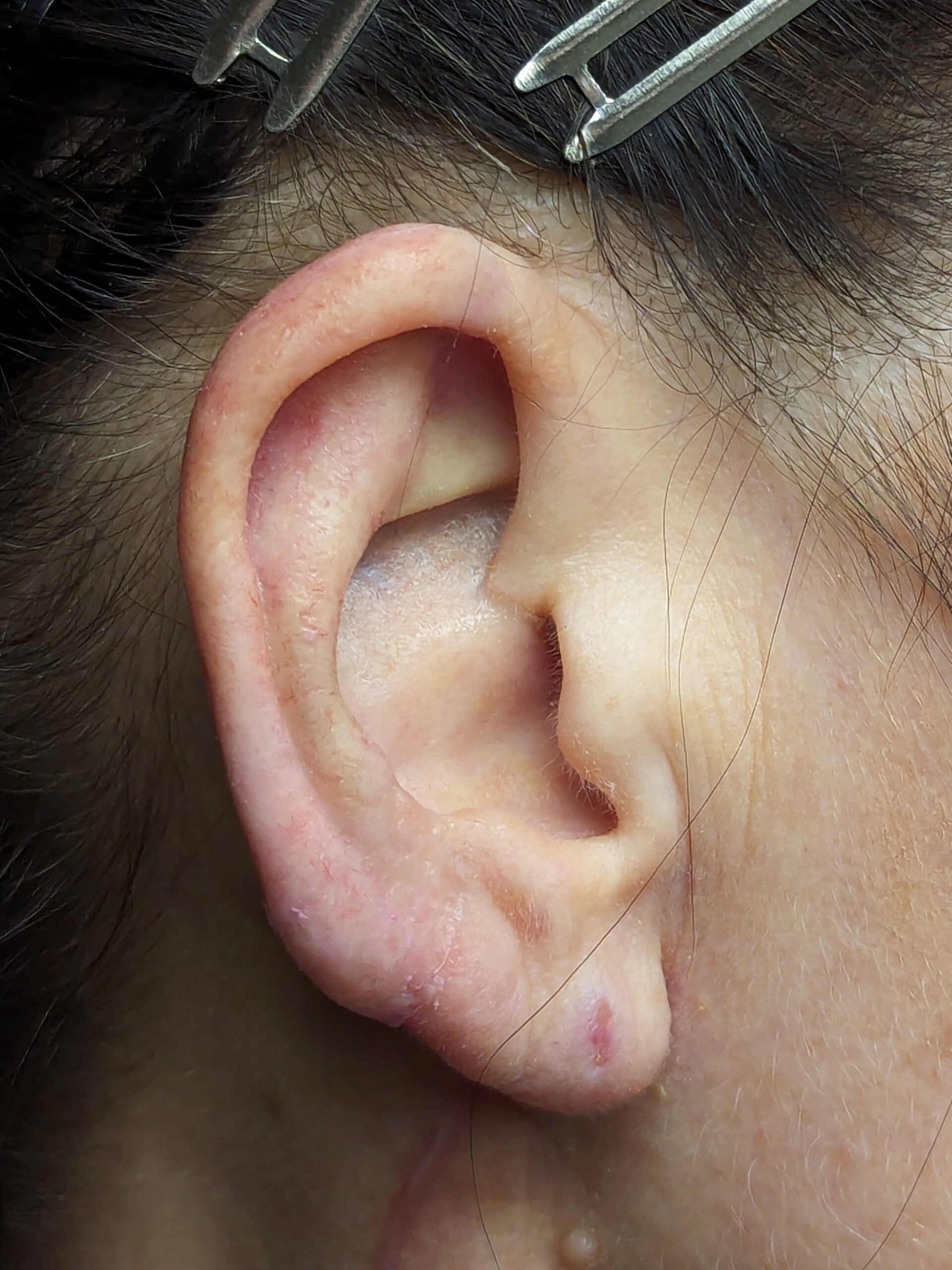
Anatomically-Retained Auricular Prosthesis
Anatomically-Retained Auricular Prosthesis
Partial or subtotal auriculectomy often leaves the cartilaginous structure of the ear remnant intact. This helps to support or suspend the partial ear prosthesis. The flexible silicone prosthesis in this case is molded to slip into the triangular fossa and cymba conchae of the remnant ear. The prosthetic ear fits into the remaining ear like a puzzle piece. Adhesive may be applied under the margins for a secure seal. A flange and groove is designed into the top of the ear prosthesis if the patient wants the extra security of attaching the ear prosthesis to his eyeglasses.
The frontal view without the ear prosthesis in place demonstrates a problem the patient encounters following partial or subtotal auriculectomy. His unsupported ear tissue droops and falls away from the side of the head. We have thoughtfully designed the ear prosthesis to lift and hold the helical remnant (rim of the ear) into its ideal position to restore symmetry of the ears. This ear prosthesis result makes the patient feel balanced and happy. We often spend extra time creating the complex molds needed to accomplish this prosthetic effect. Ear restoration and anaplastology is our specialty and we know how much easier it will be for our patient to manage his ear prosthesis each day.
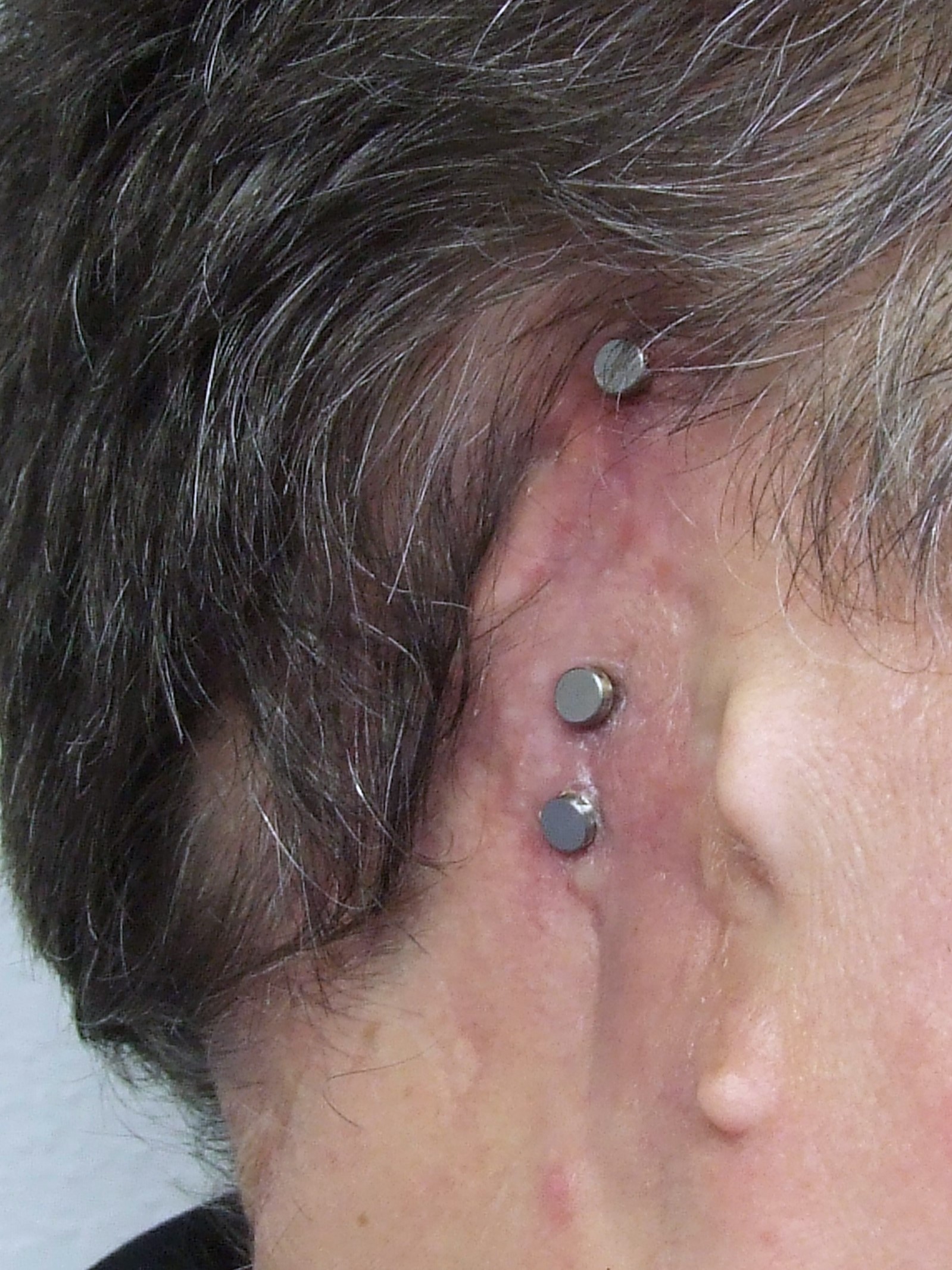
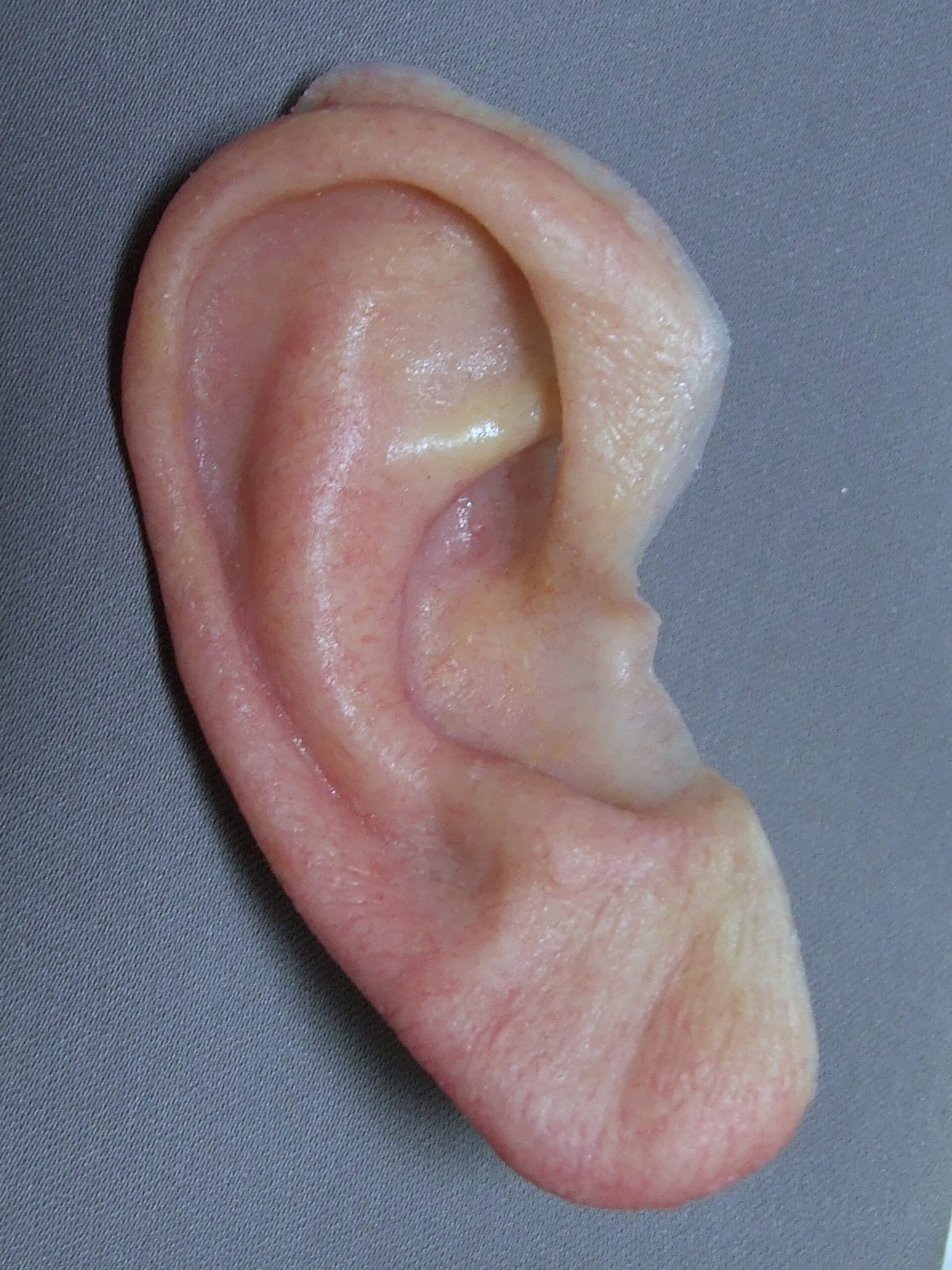
Implant-Retained Ear Prosthesis: The Magnetic Ear
Implant-Retained Ear Prosthesis: The Magnetic Ear
Photos demonstrate the osseointegration implant-retained auricular ear prosthesis. The silicone prosthetic ear has strong magnets that attach the ear securely to bone-anchored abutments.
This attachment method for the implant-retained auricular prosthesis does not require fabrication of a bar splint or use of clips that can break. Rather it uses individual titanium encased magnetic components to attach the prosthesis. Our practitioners have decades of experience with all extraoral maxillofacial and craniofacial systems such as Straumann, Vistafix Generation 3 System by Cochlear Americas, and Southern Implant. Attachments have been improved with new features such as auricular and telescopic magnacaps. We discuss all options with our patients and apply the components that offer the most secure attachment of the ear prosthesis. Each patient receives an aftercare kit with a demonstration and instructions in how to clean the prosthesis and the skin for the greatest success with their ear prosthesis
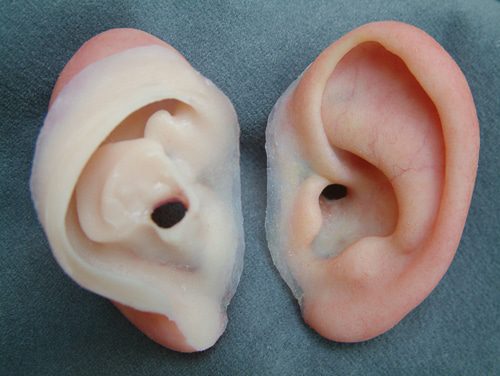
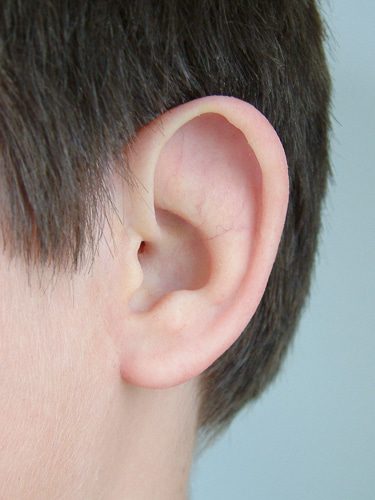
The Slipover Ear Prosthesis: Keep your Microtia
The Slipover Ear Prosthesis: Keep your Microtia
Patients and families are understandably conflicted in deciding whether to accept and live with microtia or to have more normally shaped prosthetic ears. This is because they are told by their doctors that the microtia tissue must be completely surgically removed for the installation of osseointegrated implants. It is generally true that the implant-retained type prosthesis requires removal of much or all of the microtia tissue followed by thinning of the skin. The literature also suggests this might ultimately be the best long term prosthetic attachment method for many microtia patients. However, there is also the option to do no surgery and leave the natural microtia tissue untouched. In this case a slip-over type ear prosthesis can greatly improve the anatomical aesthetics of the ear
Slip-over silicone prosthetic ears can look amazingly real and aesthetic. In ideal cases, like this, the prosthesis can be slipped on and off in seconds using a small amount of water soluble lubricant. A small amount of optional adhesive will further secure and blend the ear. Depending on the individual expression of grade 1 or grade 2 microtia patients may find great success with a slip over ear. Grade 3 and grade 4 microtia clients will use a little more prosthetic adhesive, but with less microtia tissue in the way we often get even greater bilateral symmetry of the ears using our Artec Spider hand held scanner and 3D printing system. Creating the delicate ear shapes of the helix, antihelix, and tragus is extremely painstaking for the anaplastologist, prosthodontist, or technician. However, the result can be very liberating for the patient, young or old.
This conservative non-surgical approach to ear restoration gives the patient a chance to see what it is like to have an ear prosthesis and wear it each day or just when they want. It allows them time to experience ear prosthesis wear and care, and to decide if the slip-over version is suitable for their lifestyle. This is a helpful option before taking the irreversible step of having their microtia ear tissue surgically revised or removed entirely for osseointegrated implants.




